The ship was still moving this morning when we awoke, en route back to the western side of the Aegean Sea. We were not scheduled to moor until around noon, so everyone except the captain and his mates had a chance to sleep in. Veranda, which normally opens at 7:00 a.m., did not open until 8:00 today and would be serving “brunch” until 1:00, but we decided to maintain a fairly normal schedule and went topside to eat breakfast as soon as we could.
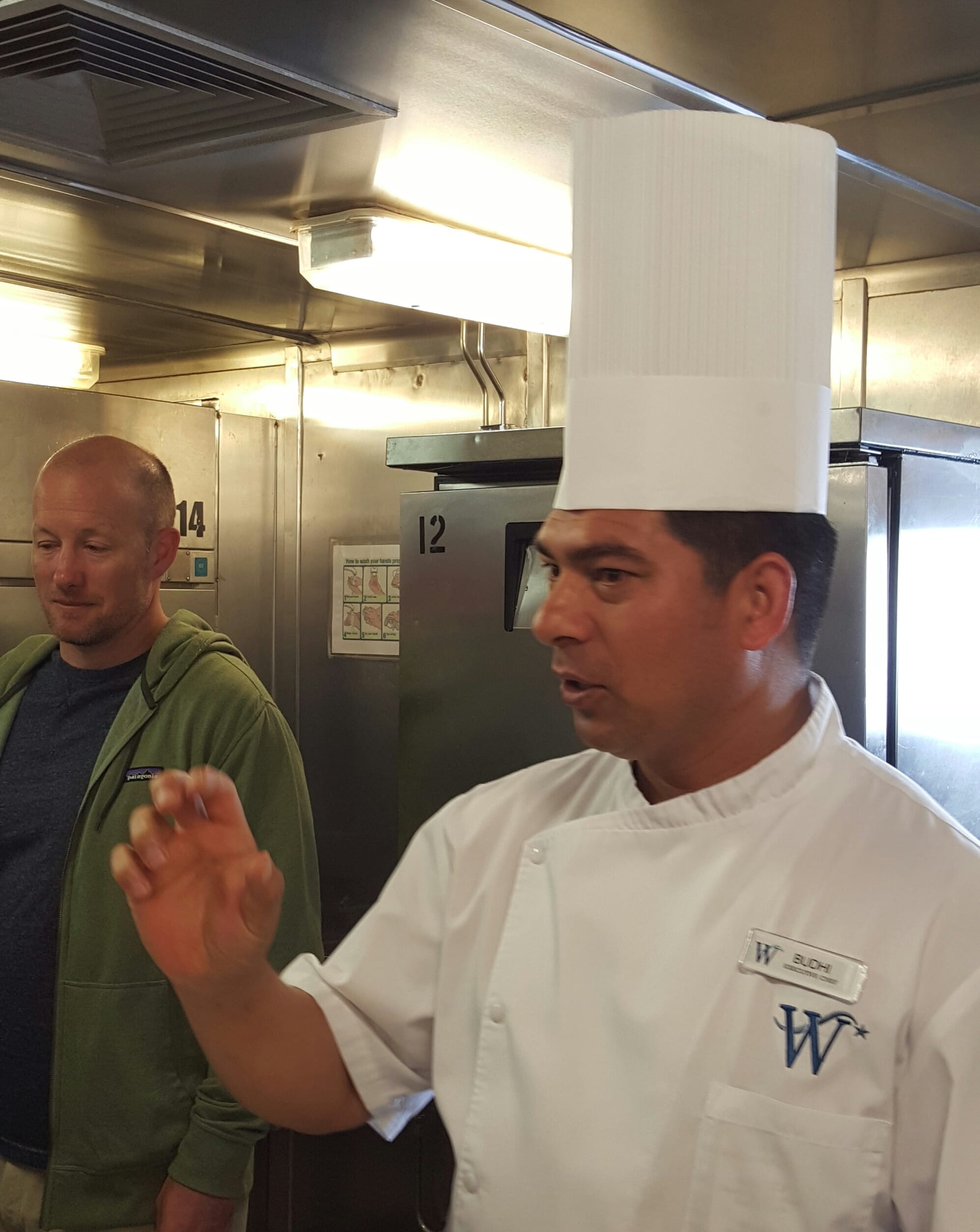
Executive Chef Budhi; the 100 pleats on his toque are said to represent the number of ways to cook an egg
We spent part of our morning on a tour of the Wind Star’s galley led by Budhi, the executive chef. The space–at least what we were able to see from the narrow aisle between sections–is divided into five stations: the first with stovetops for grilling and sautéing; the second with more stovetops for soups and sauces; alongside those is a station for preparing vegetables and fruits; the bakery for breads and pastries comes next, and then way in the back, the scullery for washing all the pots and pans. The decor throughout is dominated by stainless steel.
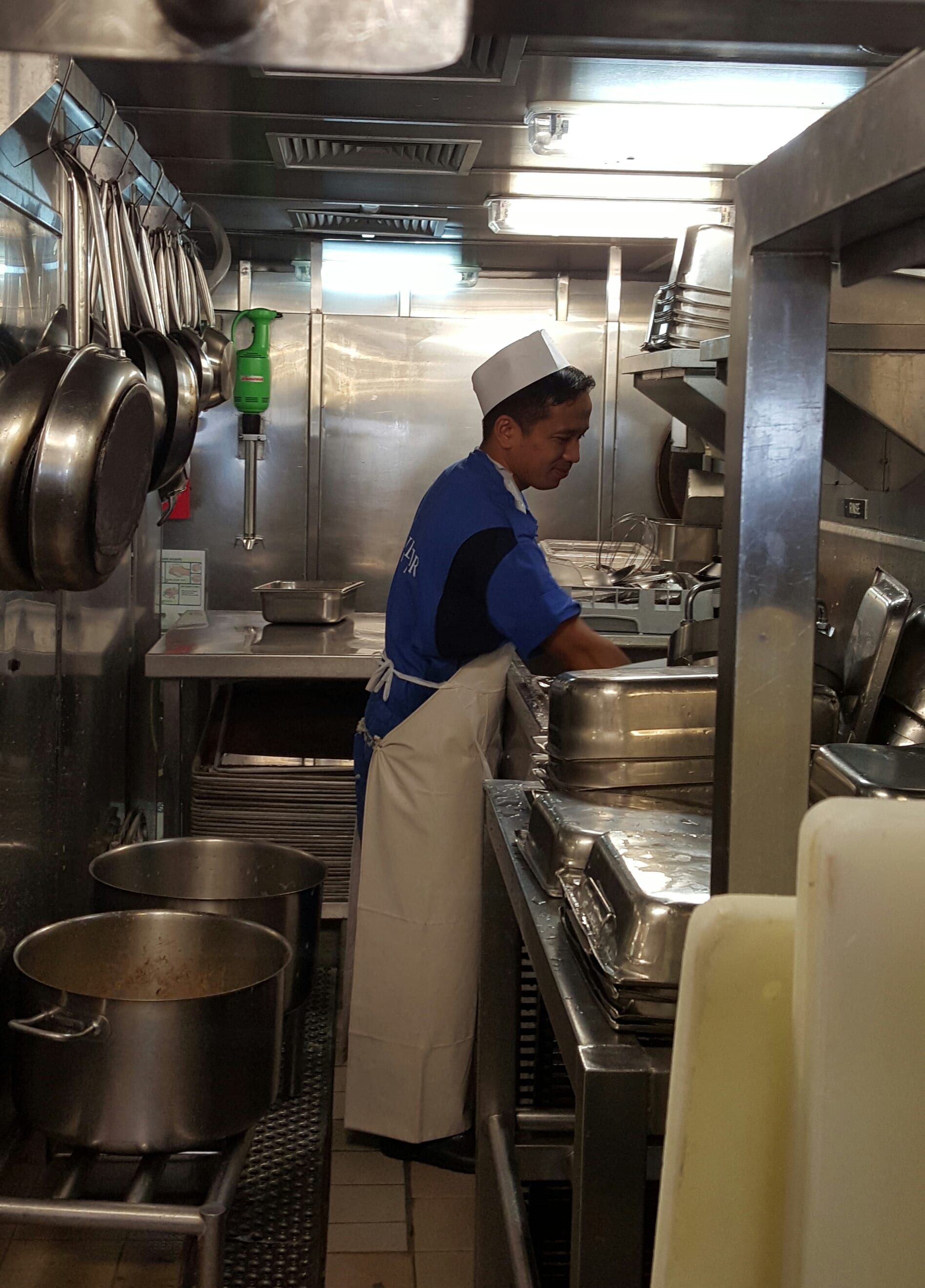
The scullery
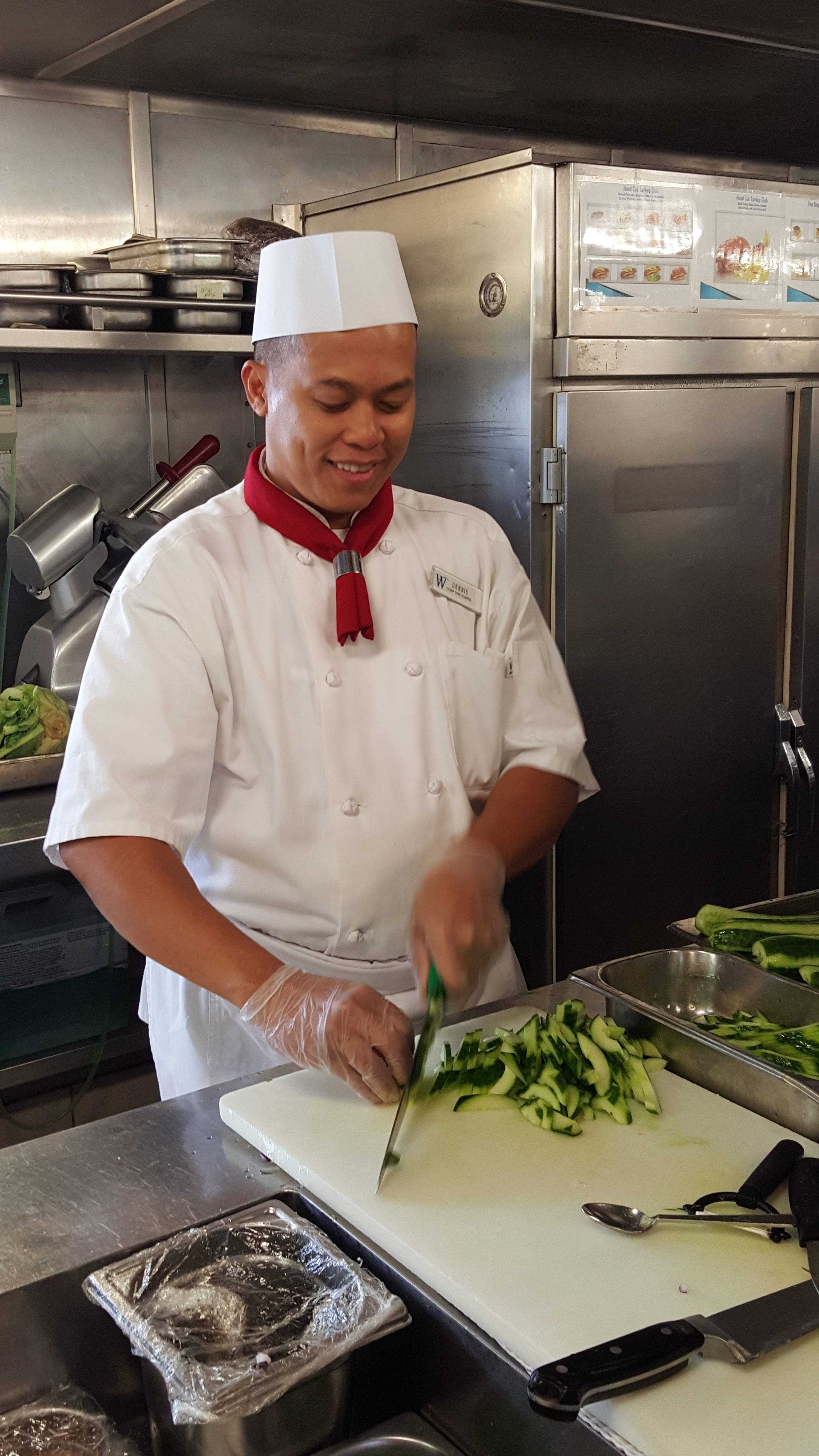
Dennis, the pantry chef, handles his knife with scary skill; sharp knives are crucial in preparing raw vegetables for a salad bar because dull blades crush rather than cut, causing foods to lose crispness more quickly
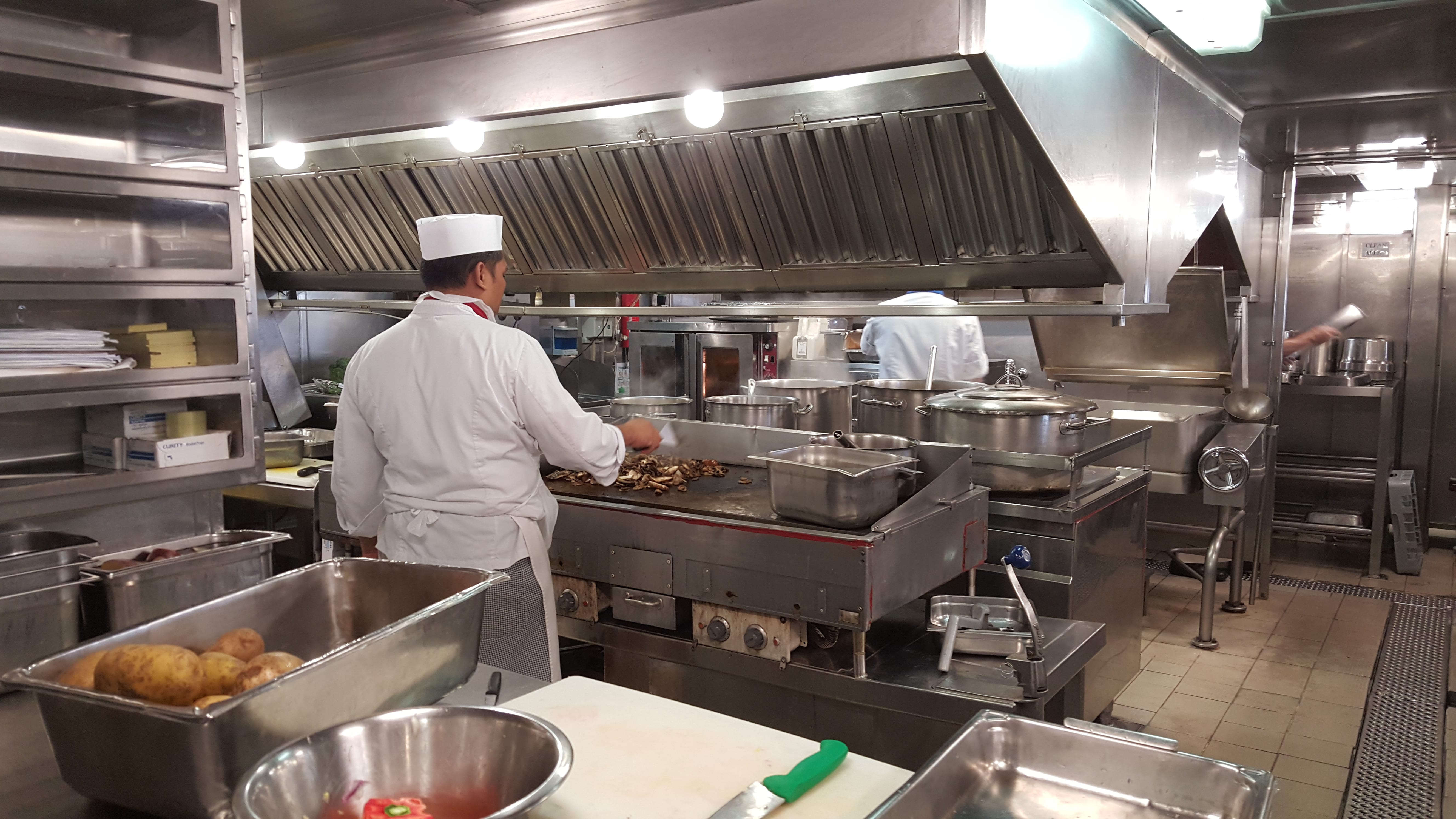
It was fascinating to watch line cooks prepare items for our lunch
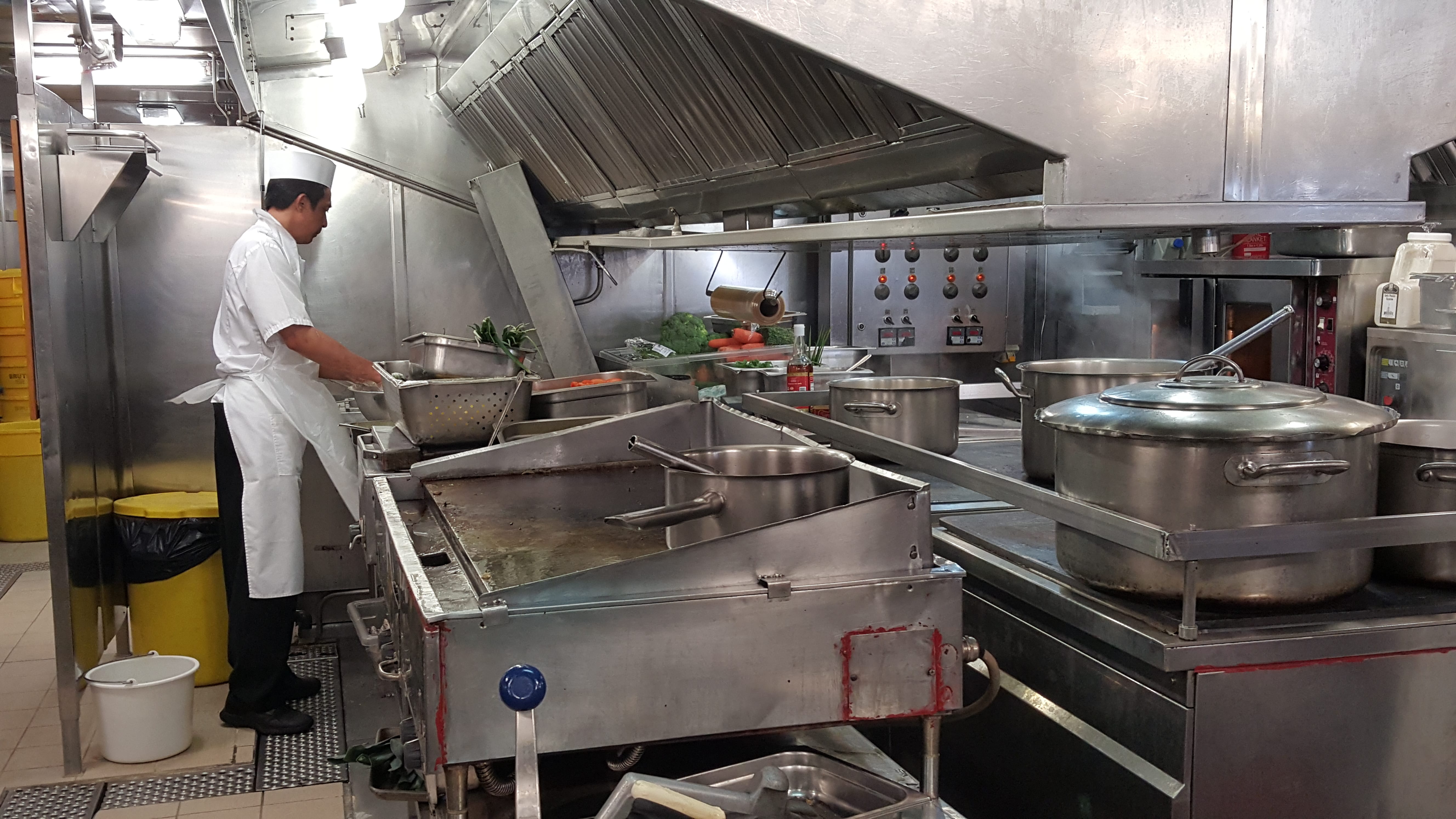
The sous chef tends five or six different pans at once, flipping, stirring, adding seasonings
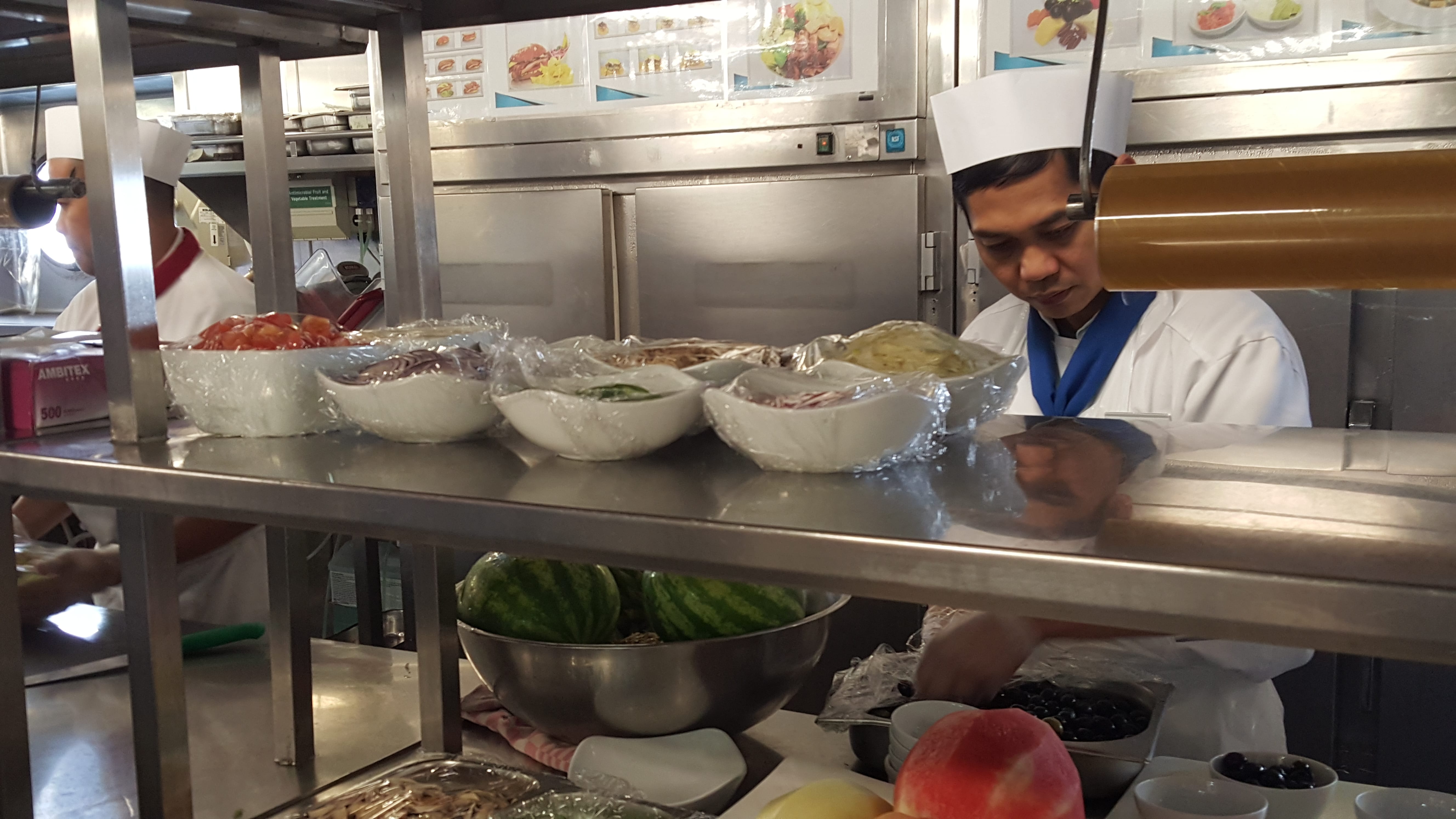
A line chef prepares dishes for the salad bar. The blue neckerchief indicates his mid-level rank
Budhi told us that besides planning menus and supervising his staff, one of his duties is to go ashore each time we put into port so he can shop for fresh local seafood, meat, and produce. We’ve appreciated his efforts! Budhi also told us that he is grateful for his position on the Wind Star because it allows him four months at home in India after every four he spends at sea. A previous job with a larger cruise line limited his time with wife and children to only three months after a nine-month work stint.
Michael was disappointed that we didn’t have a chance to tour the Wind Star’s laundry and engine room in addition to the galley. We did take advantage of a few opportunities to peek into the bridge, which is much like the cockpit of an airplane: a lot of electronics.
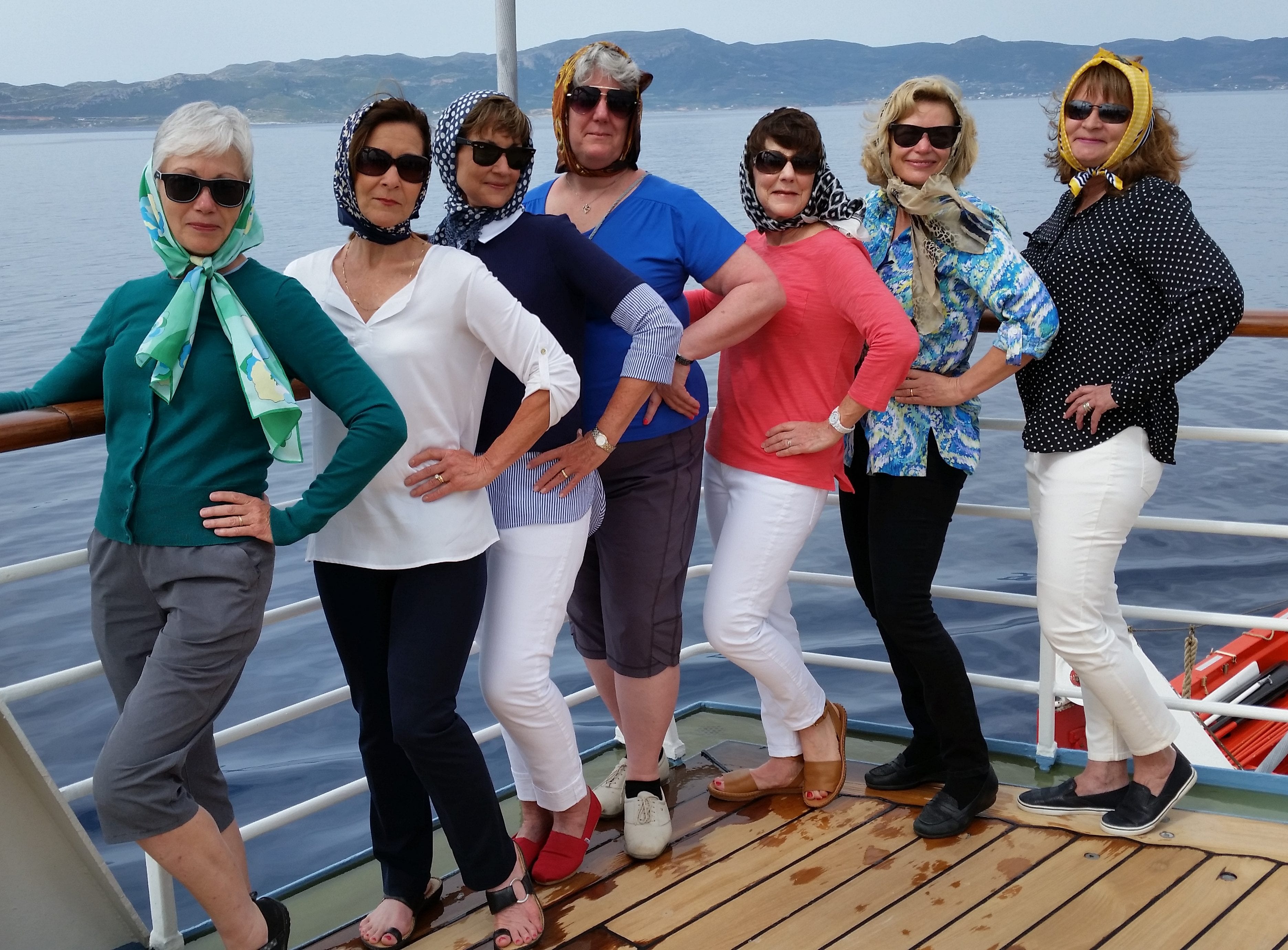
Paparazzi caught a lineup of Montgomery Ward celebrities: Nancy, Judith, Linda, Lynn, Nan, Jody, and Carol (an honorary ward member because she often is there visiting her son)
After the galley tour, we still had more than an hour before docking. We spent part of the time just enjoying the bright, breezy day and the view from the deck. Judith organized a photo shoot with the women of Montgomery Ward (our Cincinnati church congregation, not the Sears competitor) modeling in the style of Jackie O.
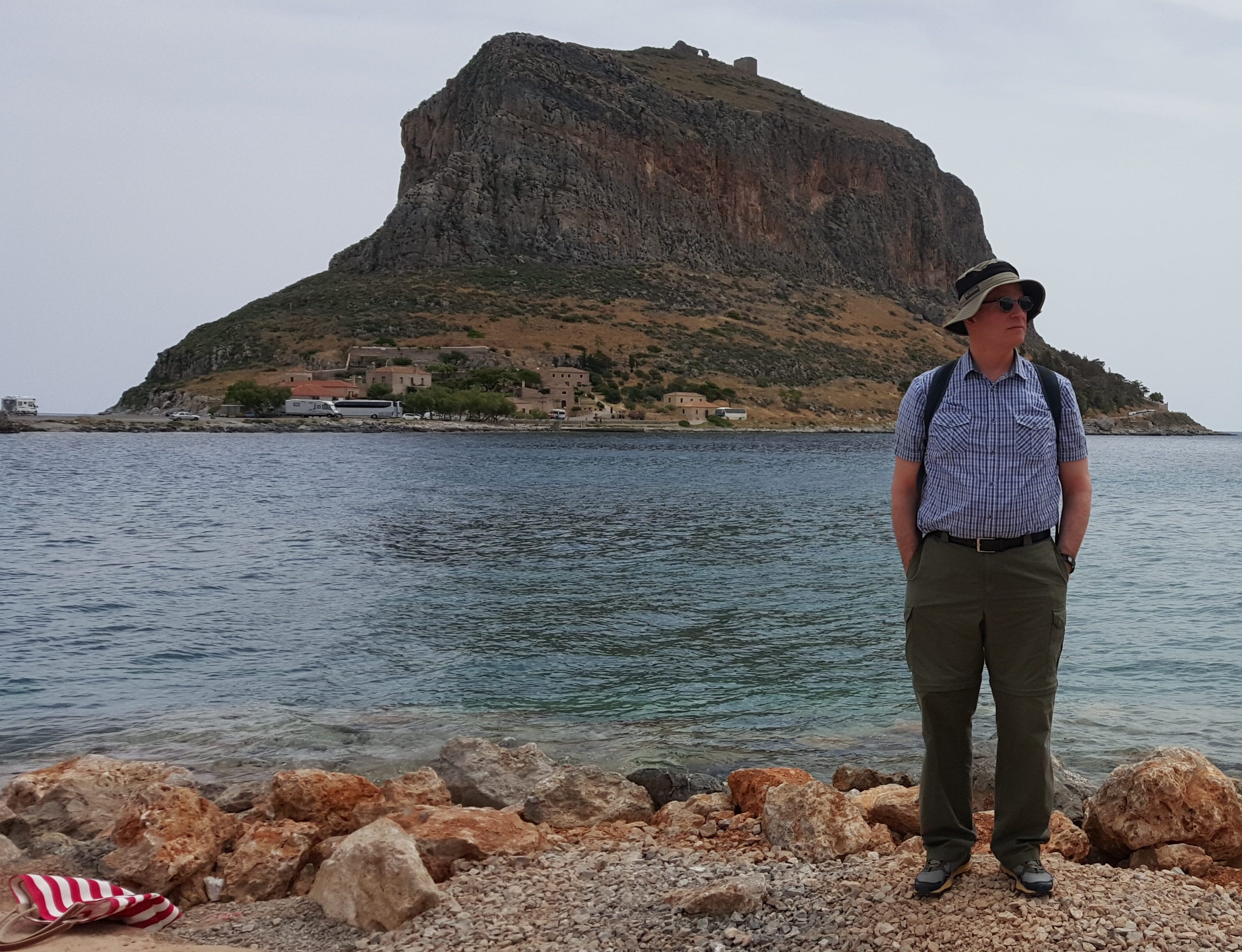
The shape of the island of Monemvasia resembles that of Michael’s hat, with a fortress on its crown; the medieval village, invisible from the mainland, sits on the brim
The ship finally reached port while Michael and Nancy were assembling portable lunches from the Veranda buffet. (Past experience has taught us to keep a couple of plastic sandwich bags in our packs for such a purpose.)

Barry was amazed by the clarity of the water at the shore
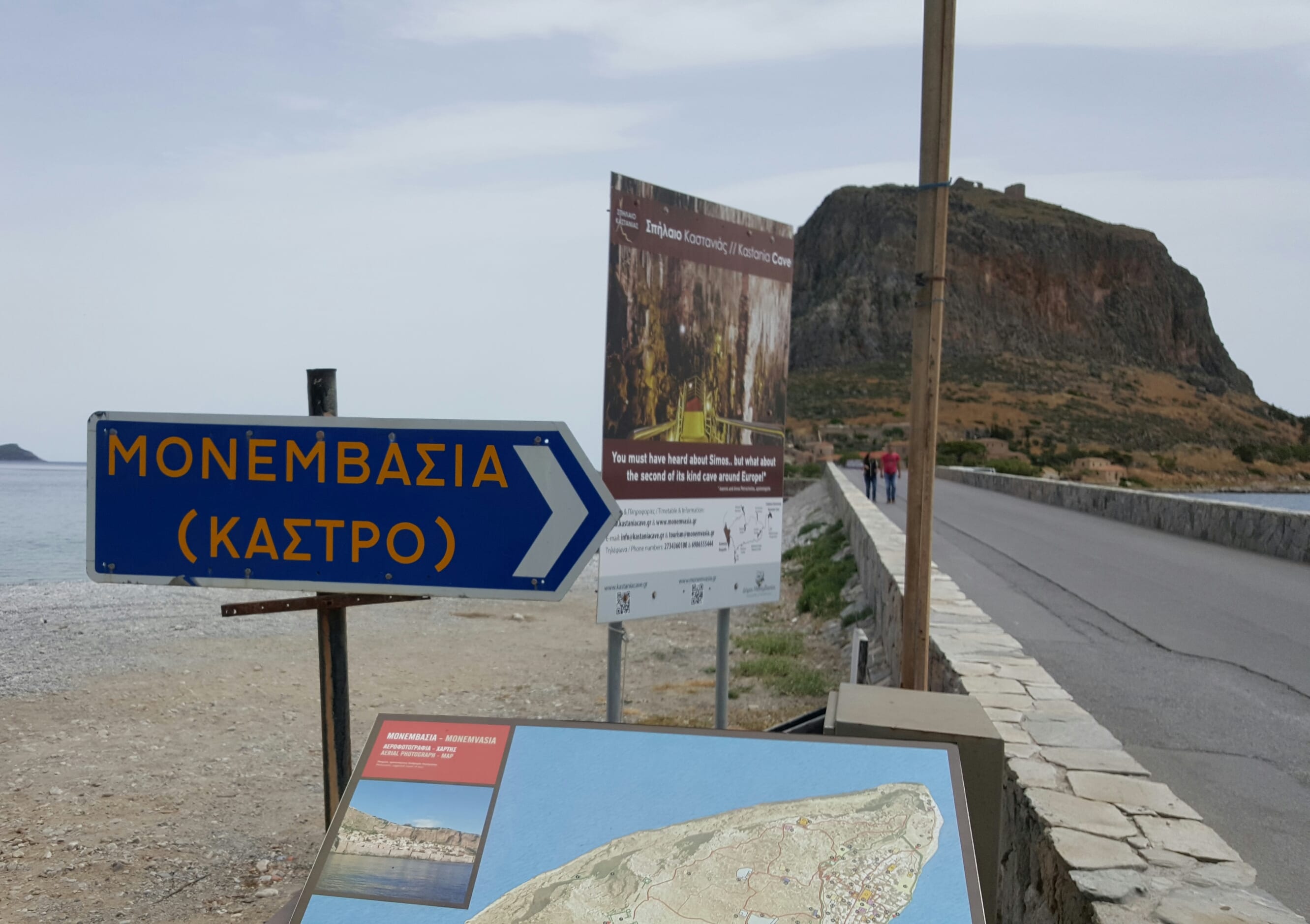
Signs mark the causeway leading to Monemvasia
We are now on the southeastern coast of the Peloponnese, near the tiny island of Monemvasia. Nicknamed the “Gibraltar of Greece,” Monemvasia is the site of a fortress built in the sixth century AD to provide ancient Laconians a refuge from Slavic invaders. (The English word laconic is derived from the traditionally terse natives of this region.) The islet also served as a base for pirates employed by rulers of the Byzantine Empire to attack enemy ships. Eventually a village grew on the narrow brim of land around the steep bluff where the castle sits. The islet was accessible only by boat until 1971, when a narrow causeway connecting it to the mainland was constructed. Despite centuries of continuous habitation, the town has maintained its quaint, medieval character; today it has become a haven for artists as well as tourists.
Shortly after noon, we took a tender to the mainland, met Iannes, our guide, and then boarded a shuttle for the brief ride across the causeway to the island. From the mainland, the only visible evidence of human habitation on Monemvasia is a knot of unremarkable 1970s-era buildings clustered around a bus station, and the completely ruined castle atop the bluff–a prospect which initially made us one wonder why Windstar Cruises bothered to include this stop in our itinerary.
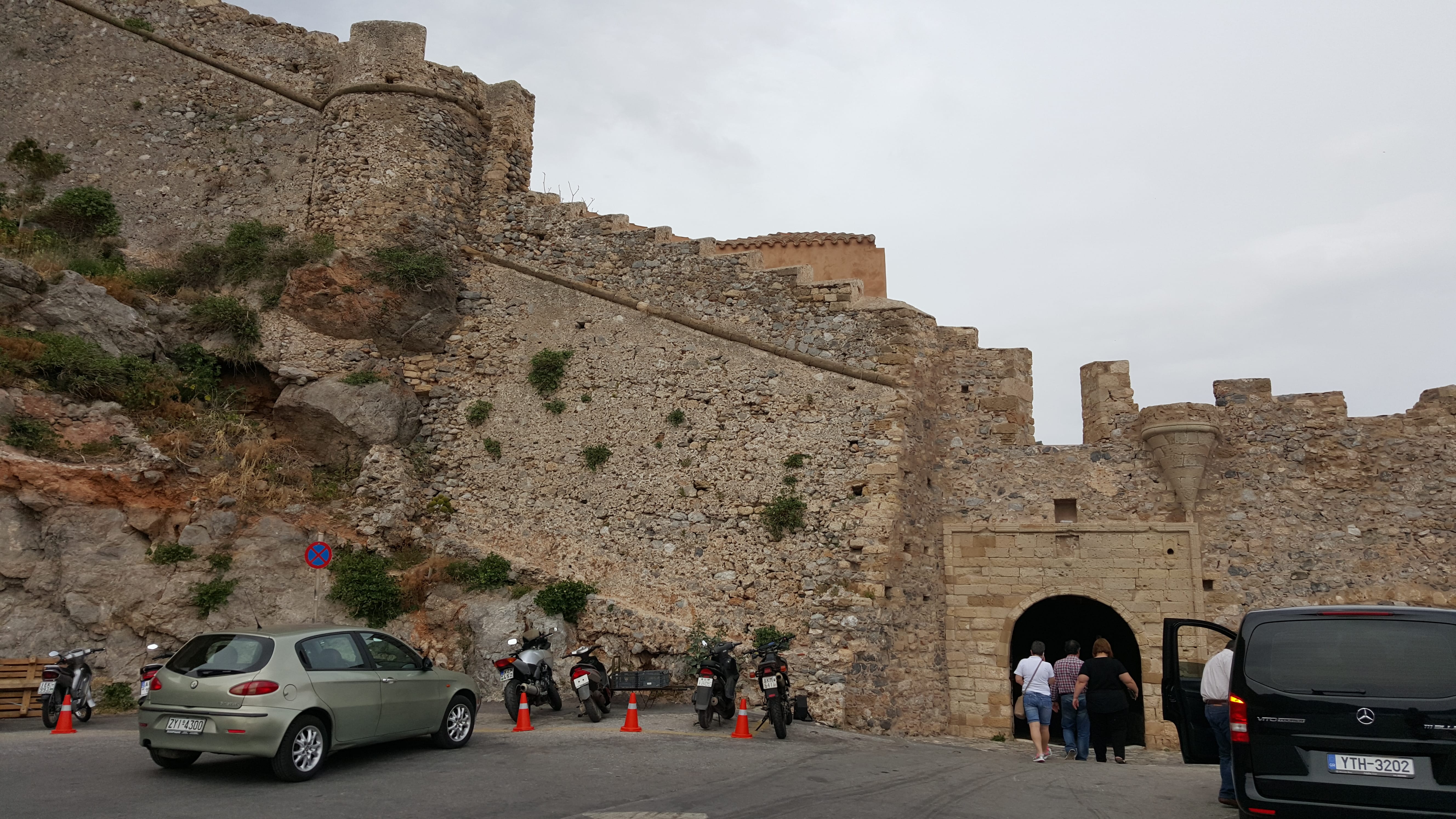
The only entrance to the city
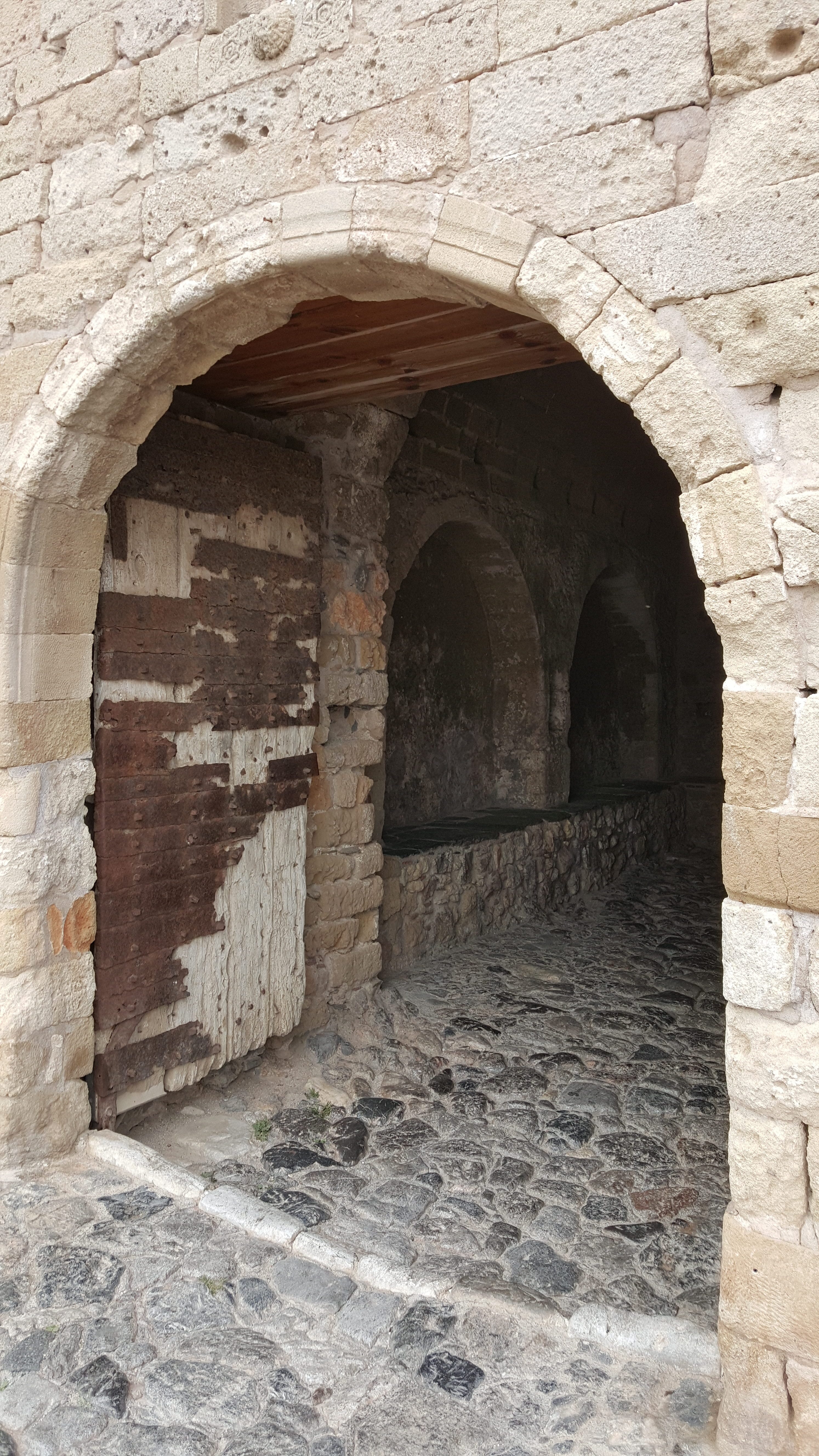
The entrance portico
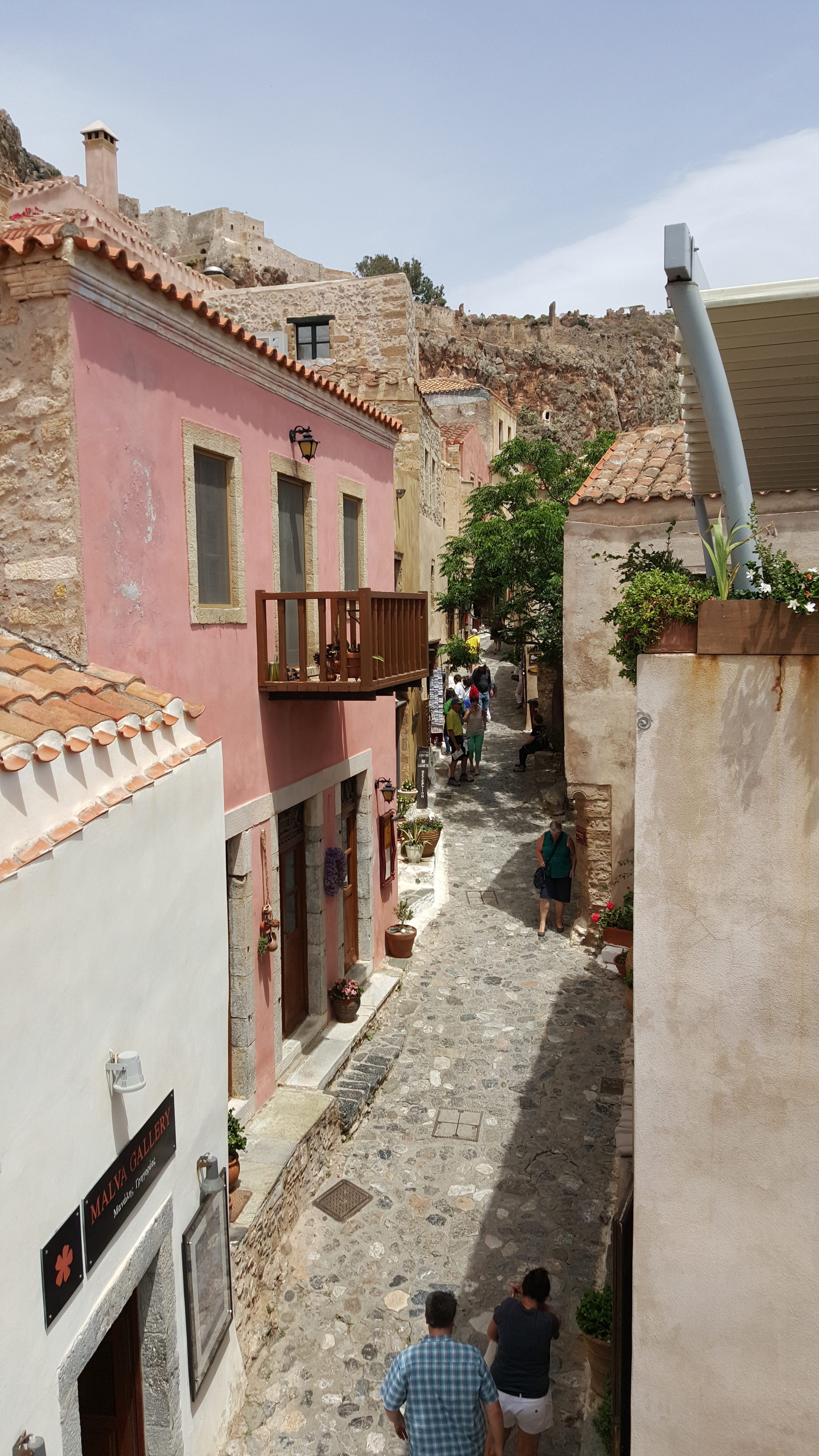
A narrow street in the upper town
Even at the end of the causeway, visitors (or invaders) meet only a forbidding, crenelated stone wall. The only way in and out of the hidden village is through an arched portico guarded by a massive, iron-clad gate. Once inside, Iannes led us through the lower town–a literally Byzantine maze of narrow passages, dark alleys, and twisting stairways–until we emerged into the sunshine of the upper town.
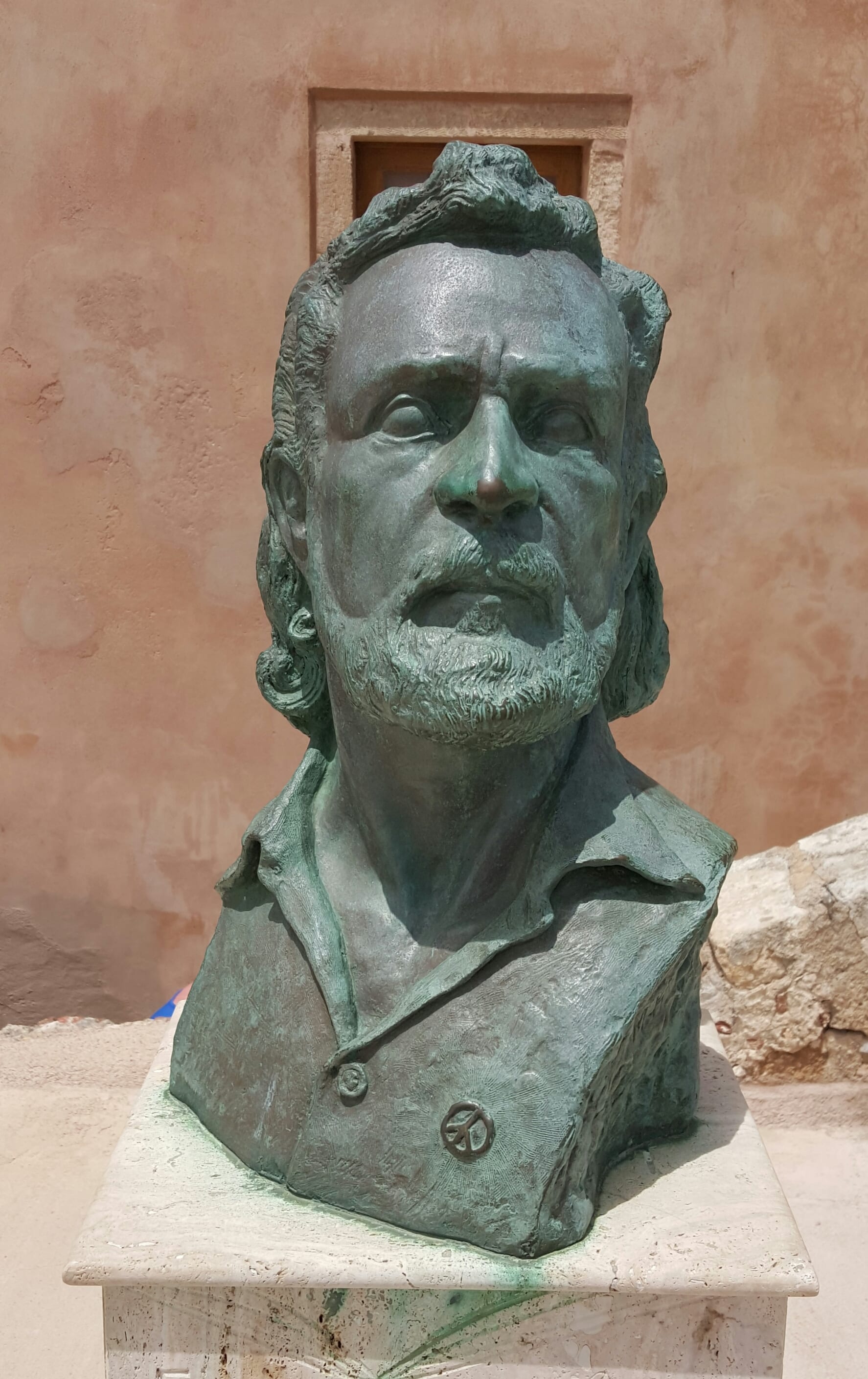
A bust of poet Iannes Ritsos, who lived and worked in Monemvasia
From there we could see not only the brilliant sky above, but also glimpses of the sea shimmering beyond the red tile roofs below us. (Jeff M remarked: “This place is like a non-stop photo-op!”) Iannes explained that in medieval times, homes, taverns, and shops were located in the lower town, where merchants traded in wine, silk, and purple dye (a rare and expensive commodity extracted from sea snails). Iannes also told us that a unique species of wine grapes once grew on Monemvasia, but the Islamic Ottomans (who frowned on alcohol consumption) destroyed the vines in the sixteenth century, and they never grew back.
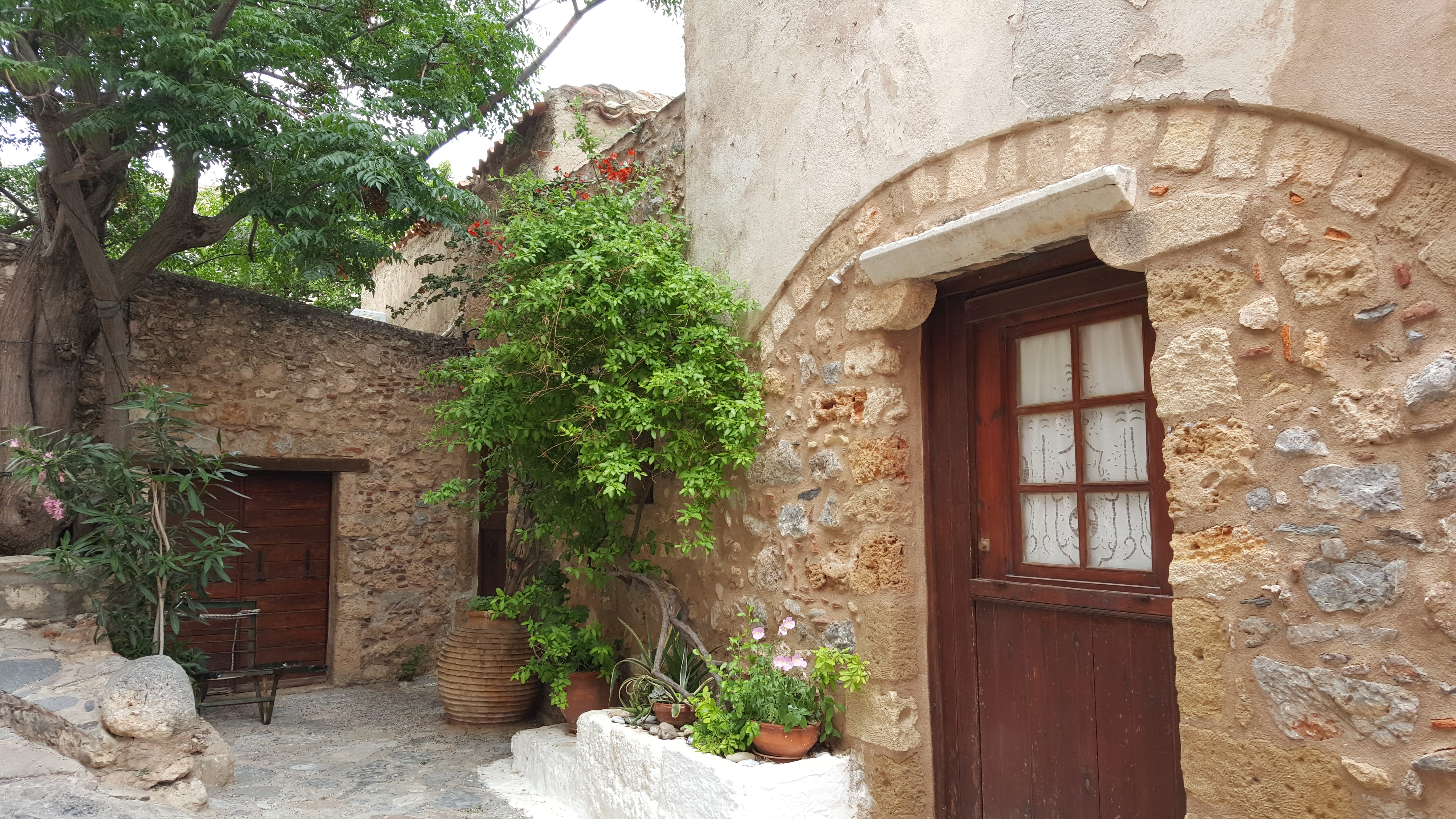
Private residence
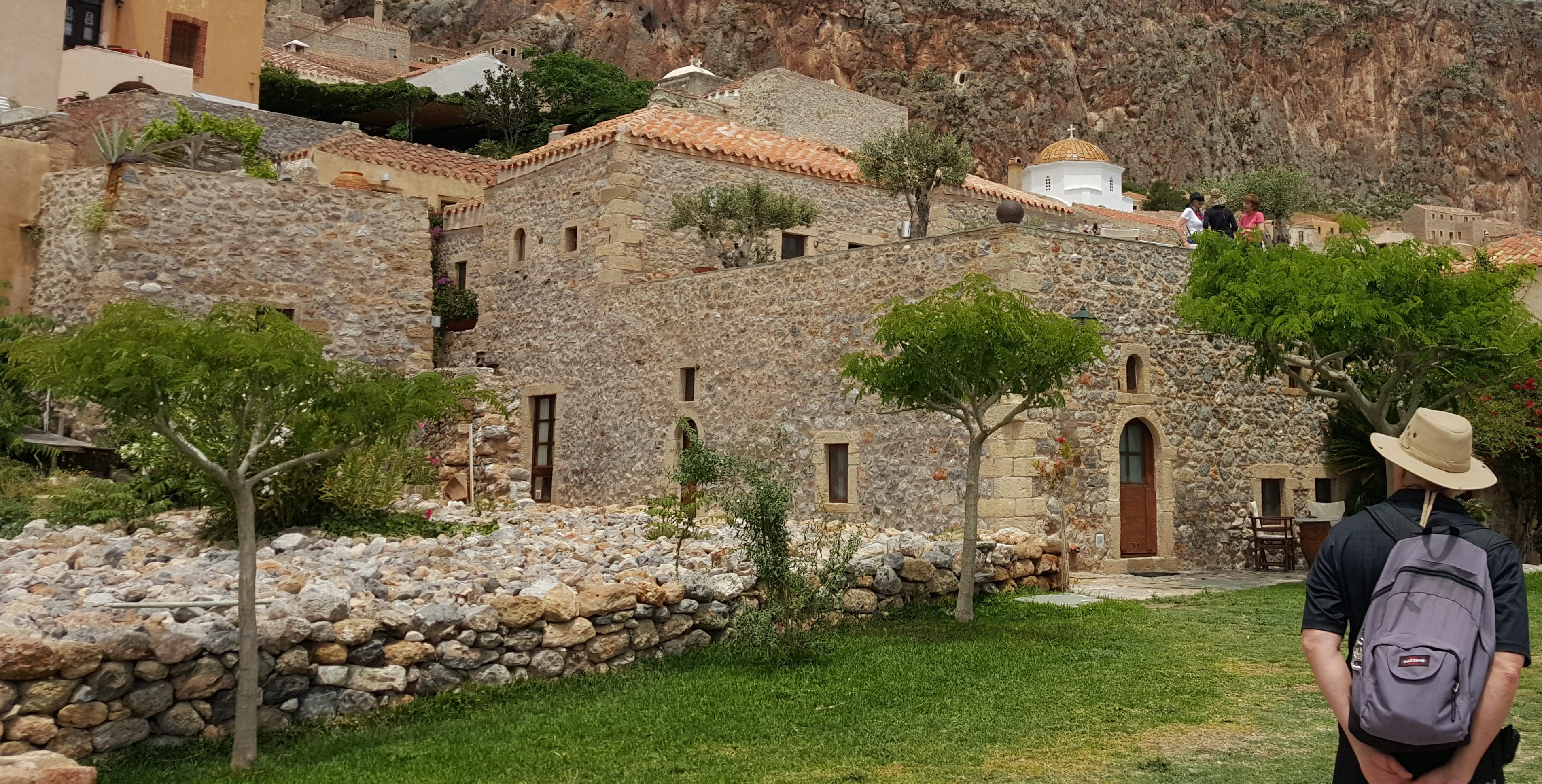
Stolakis home
The island’s upper town was the site of larger residences, civic buildings, and churches. Unlike on the other Greek islands we have visited, the stone used in most of the buildings here has not been whitewashed and retains its naturally warm colors. As we admired the relatively grand Stolakis family home, Iannes told us that most basements were built with a large water cistern because Monemvasia has no natural source of fresh water other than rain. First floors generally contain a reception room, a kitchen, and maybe a toilet; and second floors a large open living/sleeping area, sometimes divided by wooden screens.
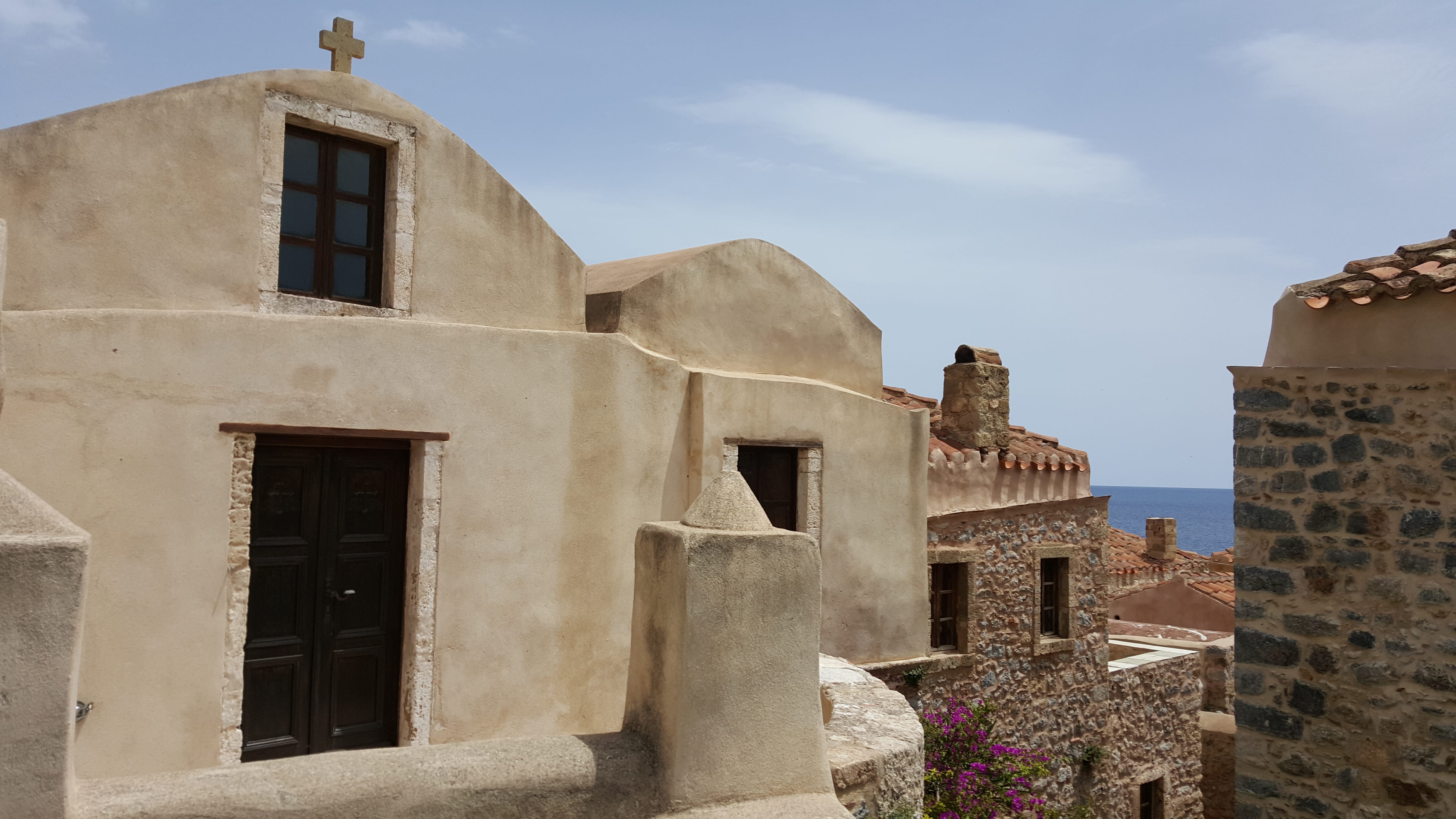
The Church of Hagios Antonios dates from 1690, during the Venetian occupation

The octagonal Church of the Golden Virgin Mary was built during the Ottoman era on the site of a well where an icon depicting the Madonna was found
For a city so small, Monemvasia seems to have an overabundance of churches. (“Why so many?” Cathy wondered. “It’s like in Orem,” Jim quipped. “Everybody’s a member, so you need a church in every neighborhood.”) As on the other Greek islands we’ve visited, most of the chapels are small, meant primarily for family worship.
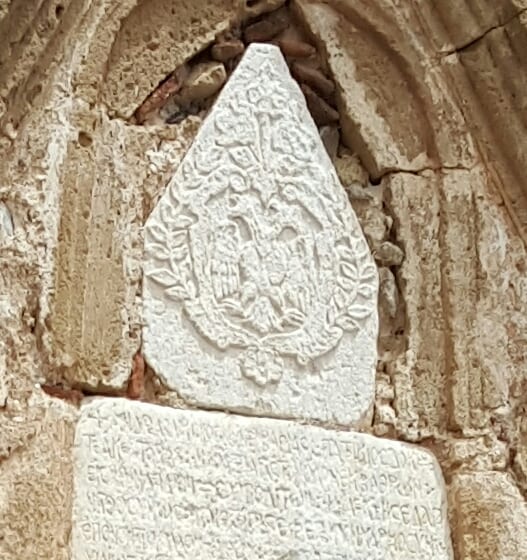
This structure can be identified as from the Byzantine era because the double-eagle crest over the door represents the eastern and western branches of the empire
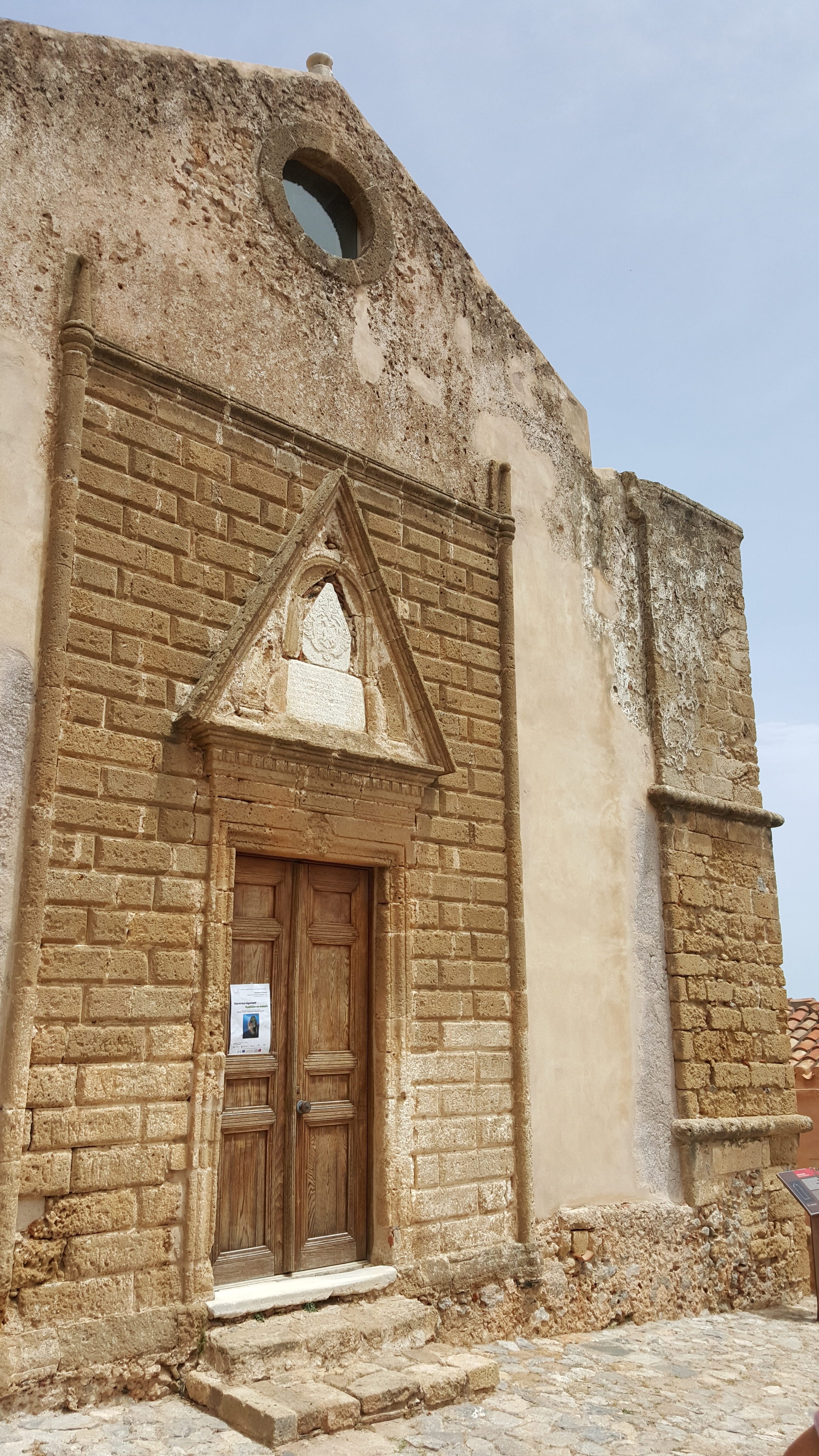
Although it began as a church dedicated to St. Nicholas, this building was used more as an armory, and since the eighteenth century has been a school
While we stood listening to Iannes in the upper town square, we were alarmed to hear what sounded like an approaching swarm of bees. We were relieved when it turned out to be a drone–though perhaps we should have been equally alarmed to learn that we were being surreptitiously monitored.
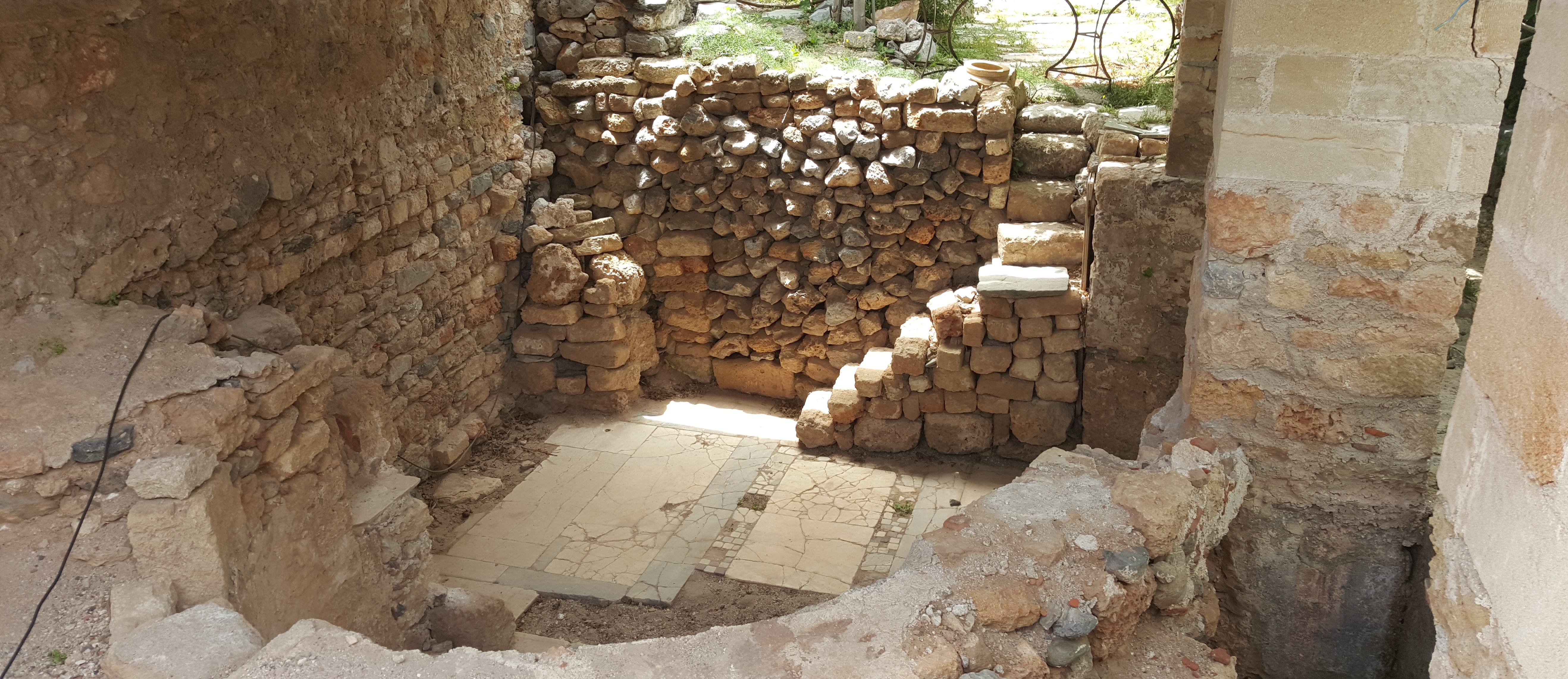
Ruins of an 8th-century church
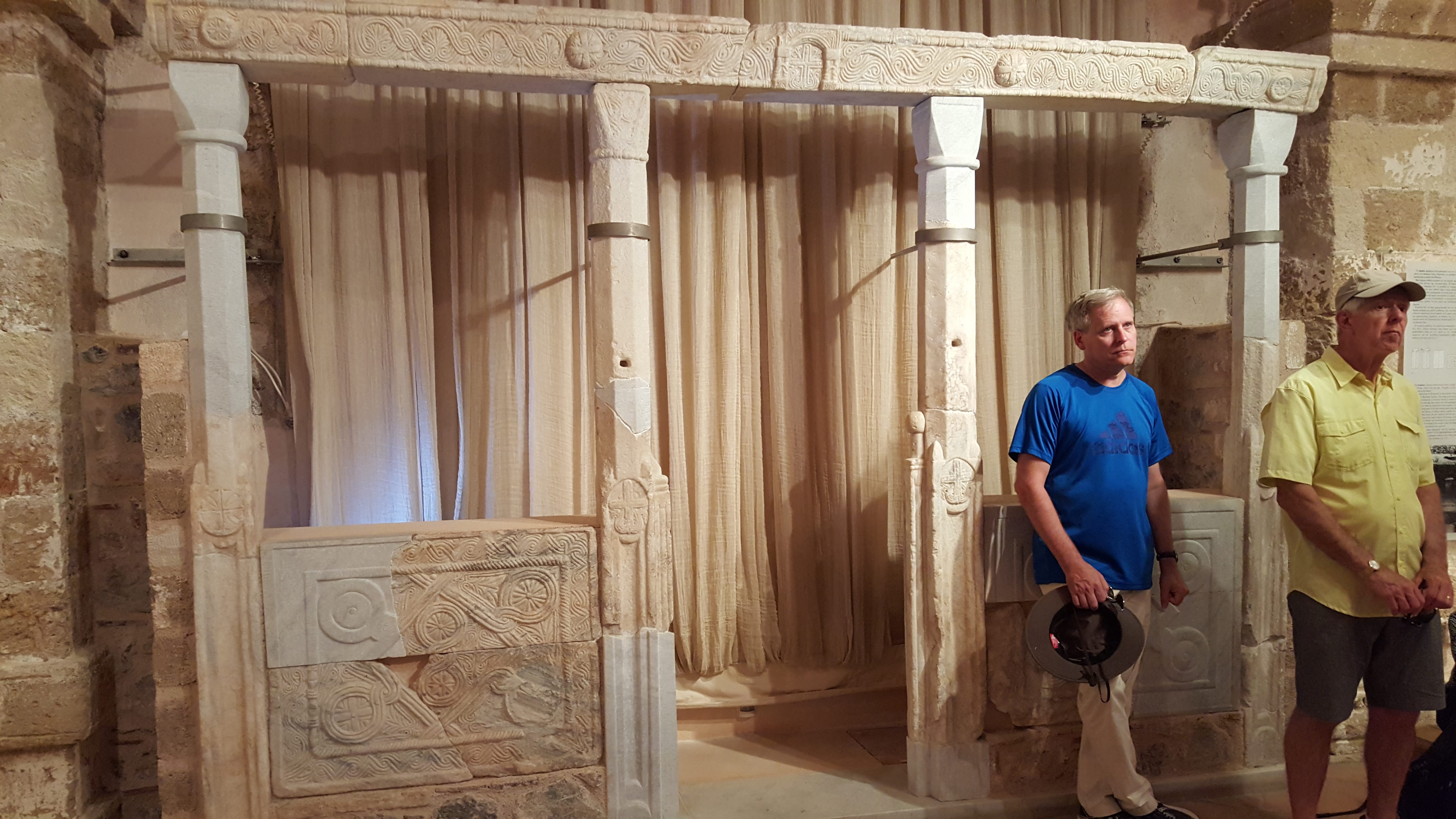
Dyrk and Budge near the 8th-century marble iconostasis
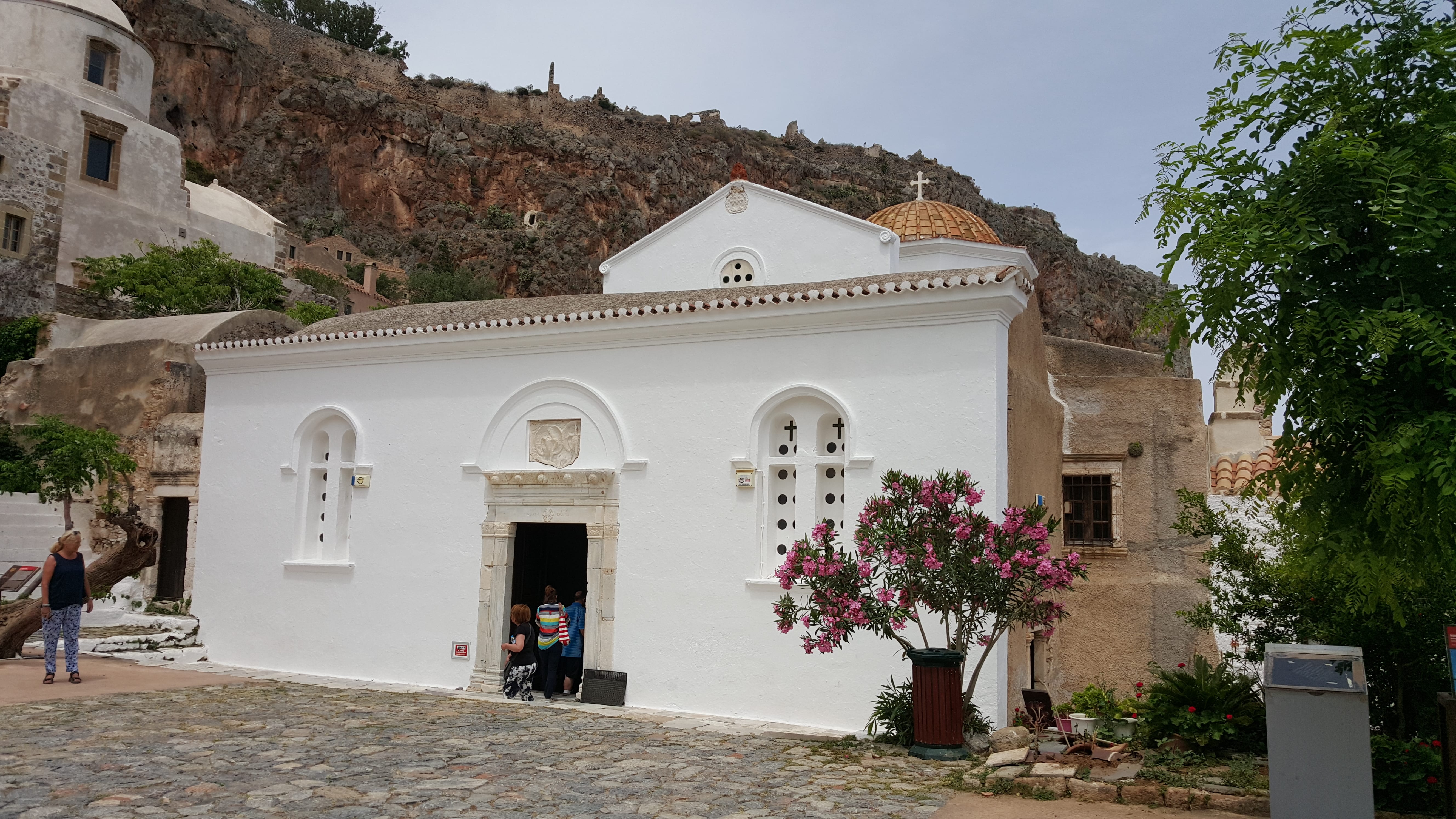
The Church of Christ Elkomenos (Christ on the Road to Calvary) contains a significant 14th-century painting of the Crucifixion
The Monemvasia Archaeological Museum is housed in a former monastery, also used as a mosque during the Ottoman occupation. The artifacts within graphically show the influence of the various nationalities and religions that have successively dominated the local culture. One of the most significant pieces on display is a marble iconostasis found in the ruins of an eighth-century church we had seen earlier. Most iconostases–decorated screens that separate the sanctuary from the nave in Eastern Orthodox churches–are made of wood, so this example of carved stone is very unusual. Our LDS group found it especially intriguing because it resembles the gateway leading to the most sacred area within our own temples.
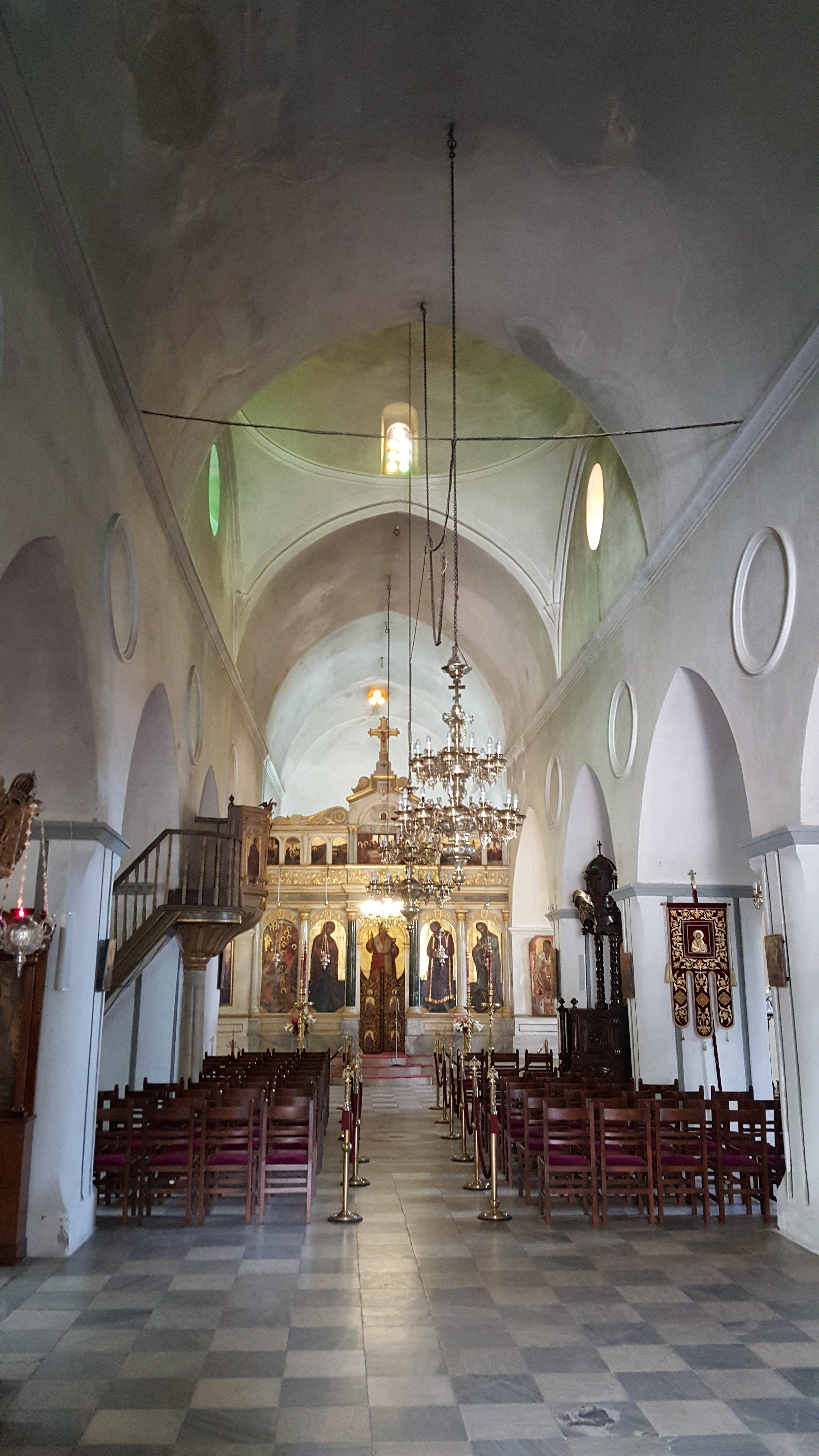
Interior of the Church of Christ Elkomenos
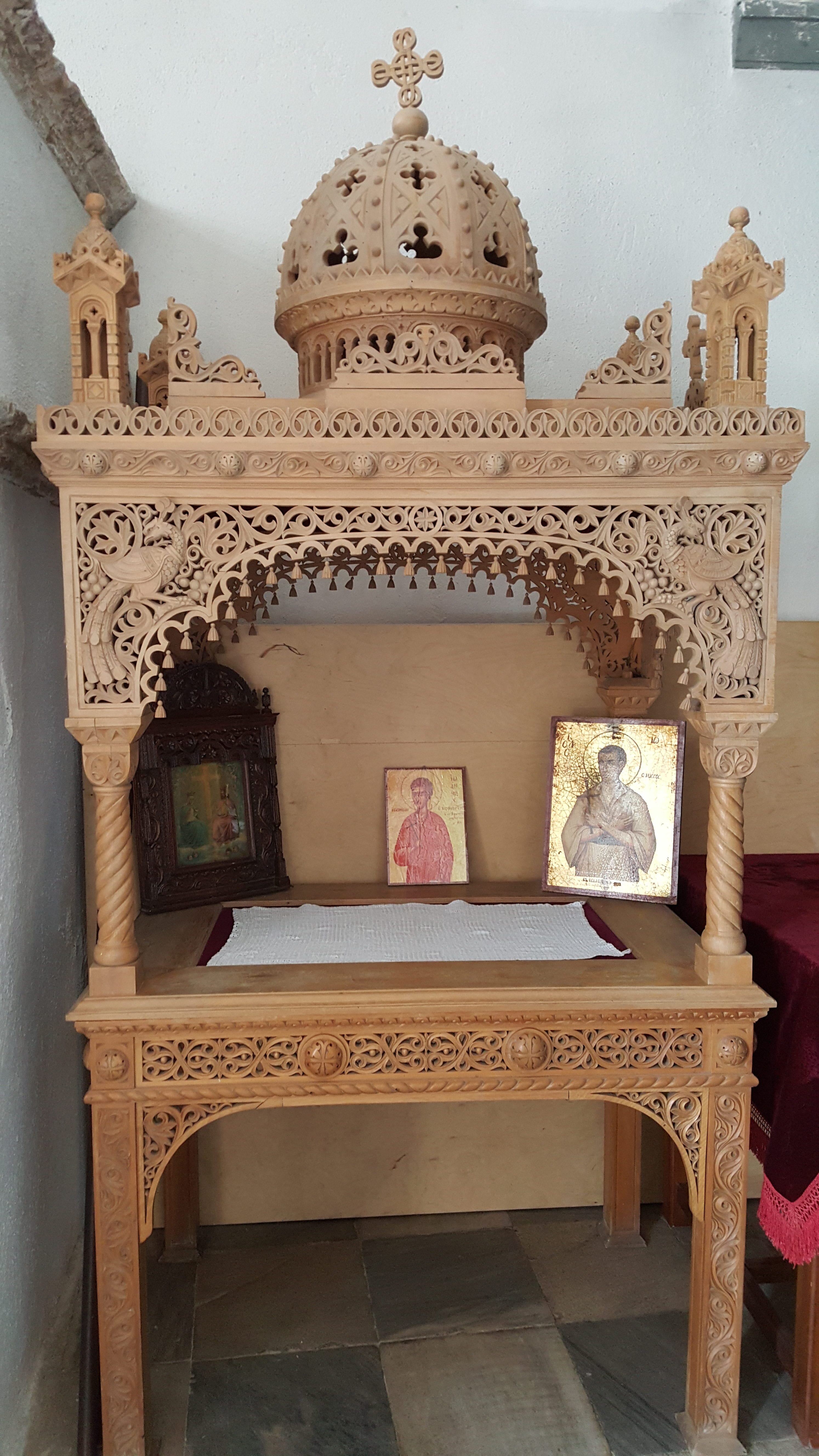
An elaborate wooden shrine within the Church of Christ Elkomenos
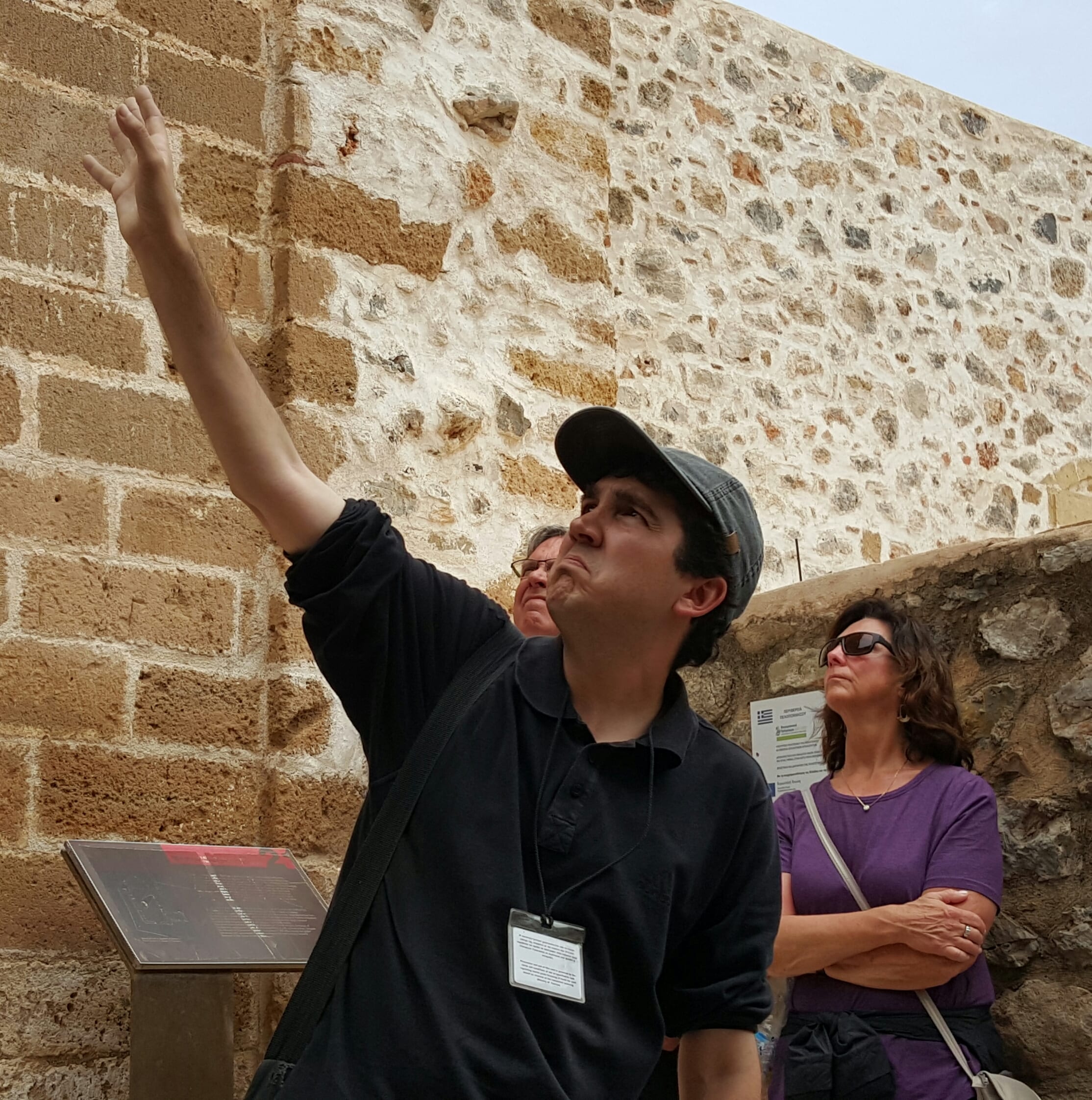
Steve and Jan observe while Iannes points out details of another church
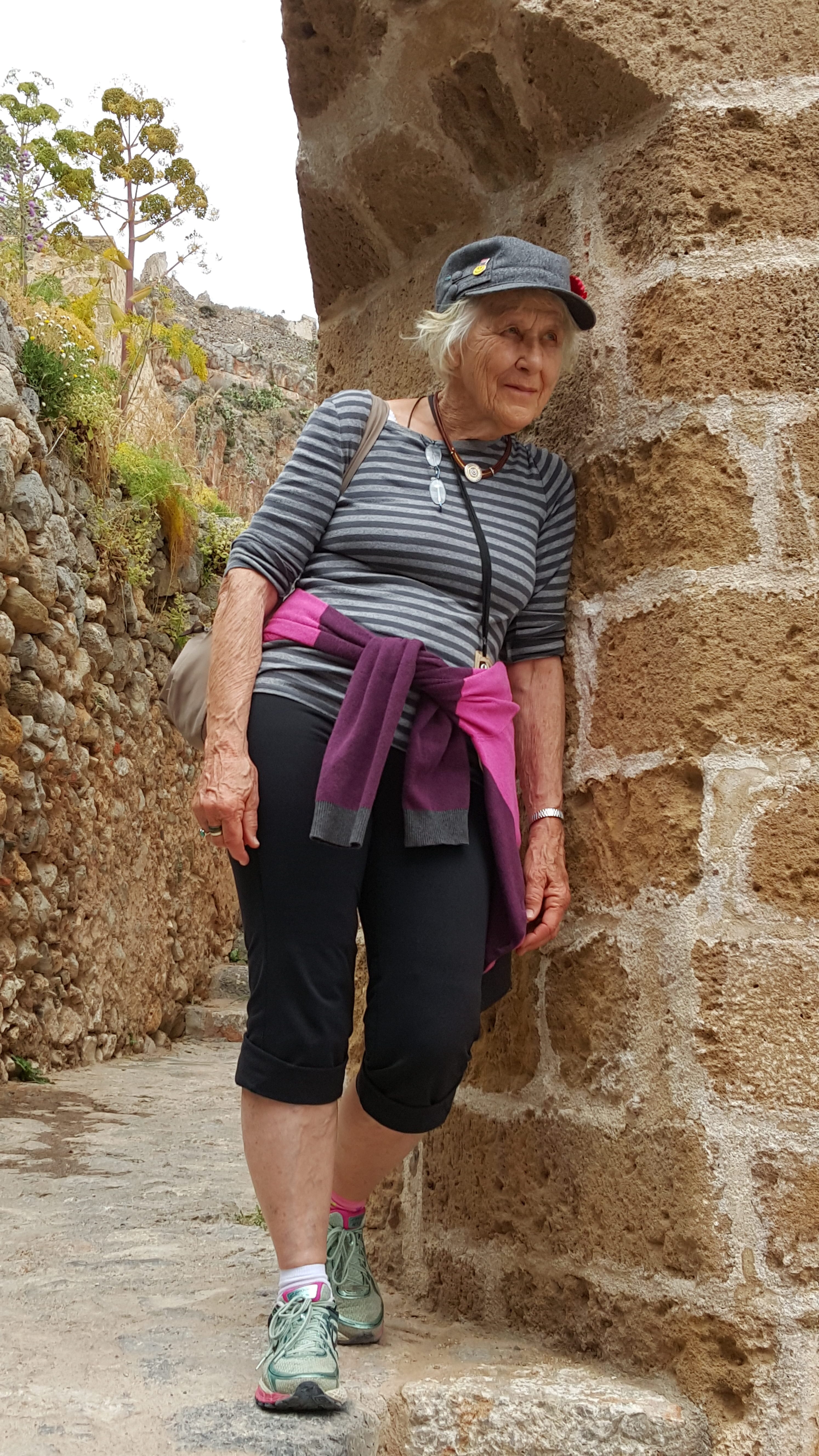
Amanda listens carefully to the guide’s commentary; the stairs behind her lead to the ruins of the fortress atop Monemvasia
After we visited a few more churches, Iannes left us to explore on our own for a couple of hours. Michael was among those who climbed the steep stairs to the ruined fortress on the island’s highest plateau.
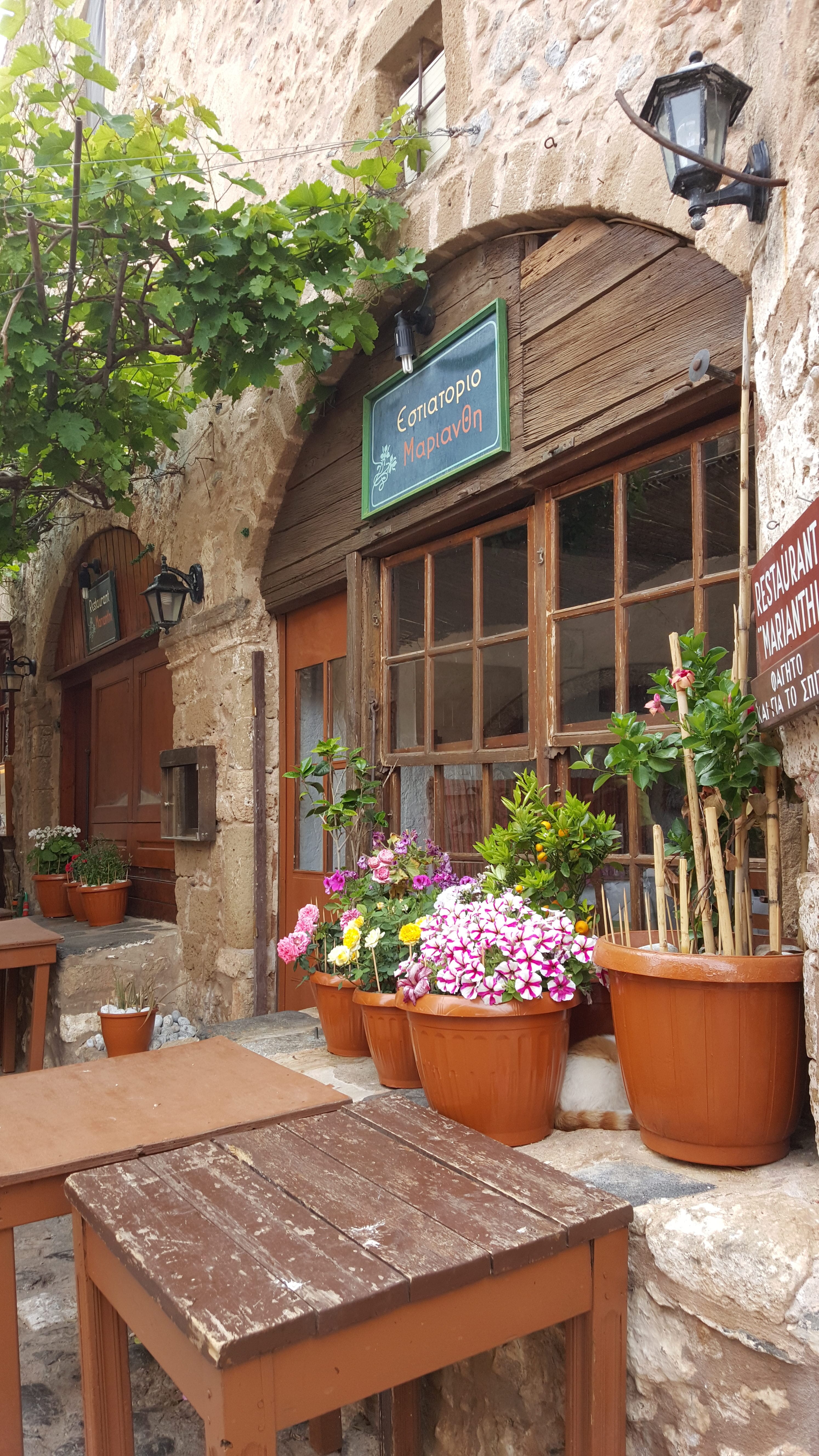
Quaint shop
Nancy decided that after yesterday’s long ascent of the Karavolades Stairs in Santorini, she had climbed enough mountains for the week and sought a chair in the shade where she could eat the lunch she had packed. She also enjoyed meandering through the narrow lanes, admiring the wares of local artisans. (She wishes more jewelry makers would create clip-on earrings.)
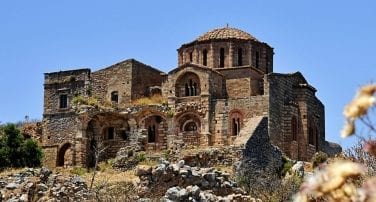
Church of Agia Sophia at the top of Monemvasia
Nancy eventually allowed herself to be drawn inside a gelateria and decided to try an unfamiliar flavor: kaimaki, which the girl behind the counter described as “like vanilla, but different.” Nancy had to google the term to learn that kaimaki ice cream is made with gum mastic and salep, a substance derived from orchid roots; both impart a distinctive chewy quality to the ice cream as well as a subtle flavor not quite like vanilla. Okay, let’s try this Greek specialty, Nancy thought. The salesgirl recommended that she order kaimaki as many Greeks do: topped with cherry sauce. Nancy’s eyes traveled to the bottles of artificially fortified fruit syrups on the counter and she was about to say “No, thanks” when the girl said, “We have some homemade; do you want to try that?” So how could Nancy choose anything else?
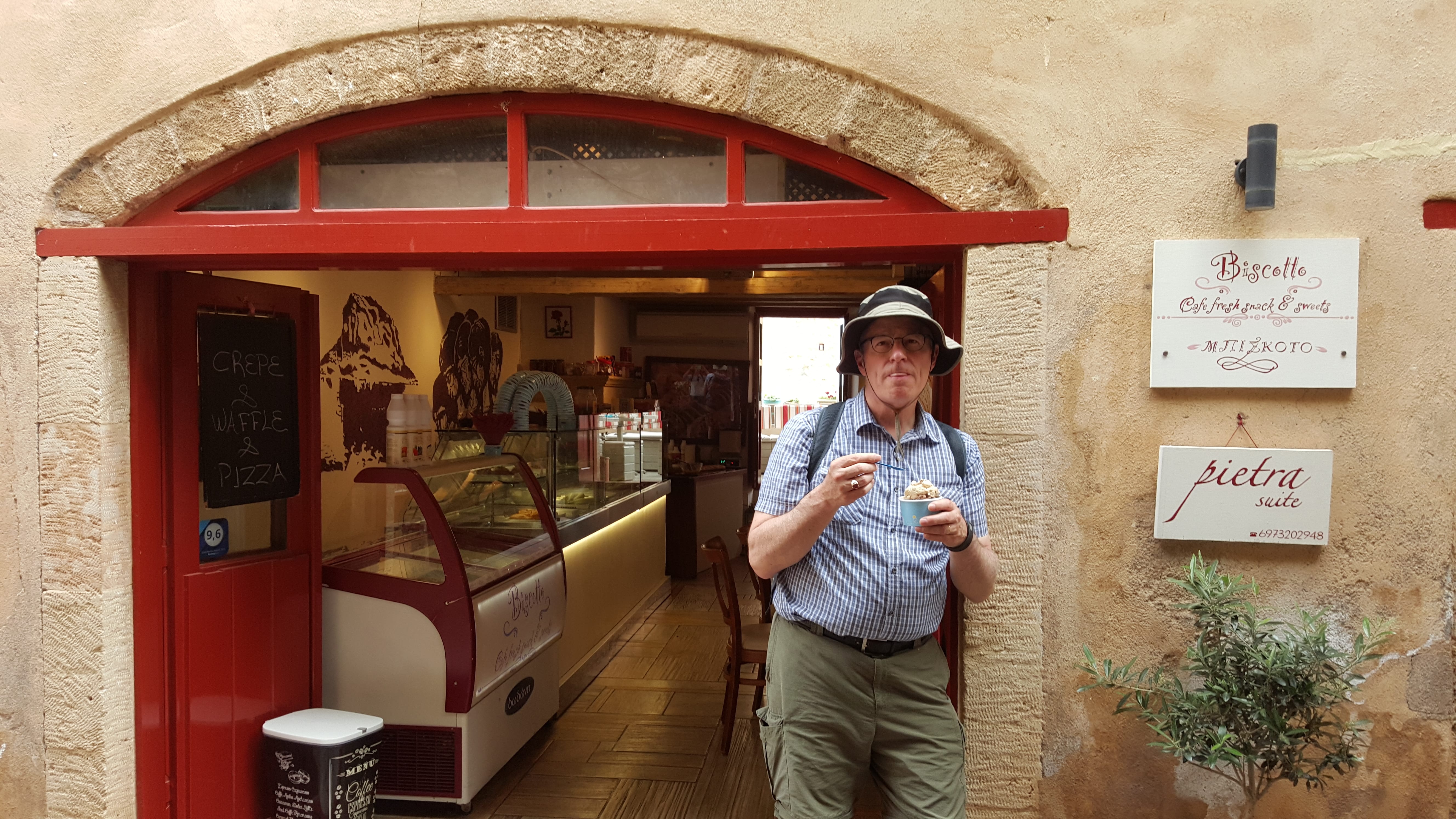
Michael savors his gelato outside Biscotto
Emerging from the gelateria with her cherry-kaimaki sundae, she nearly bumped into Michael, who (no surprise) was on his way in. Nancy walked on ahead a few steps to join Cathy and Jeff at a table in the shade while Michael went inside to choose his own treat. Bypassing the local specialty, he came out with a cup of chocolate and caramel.
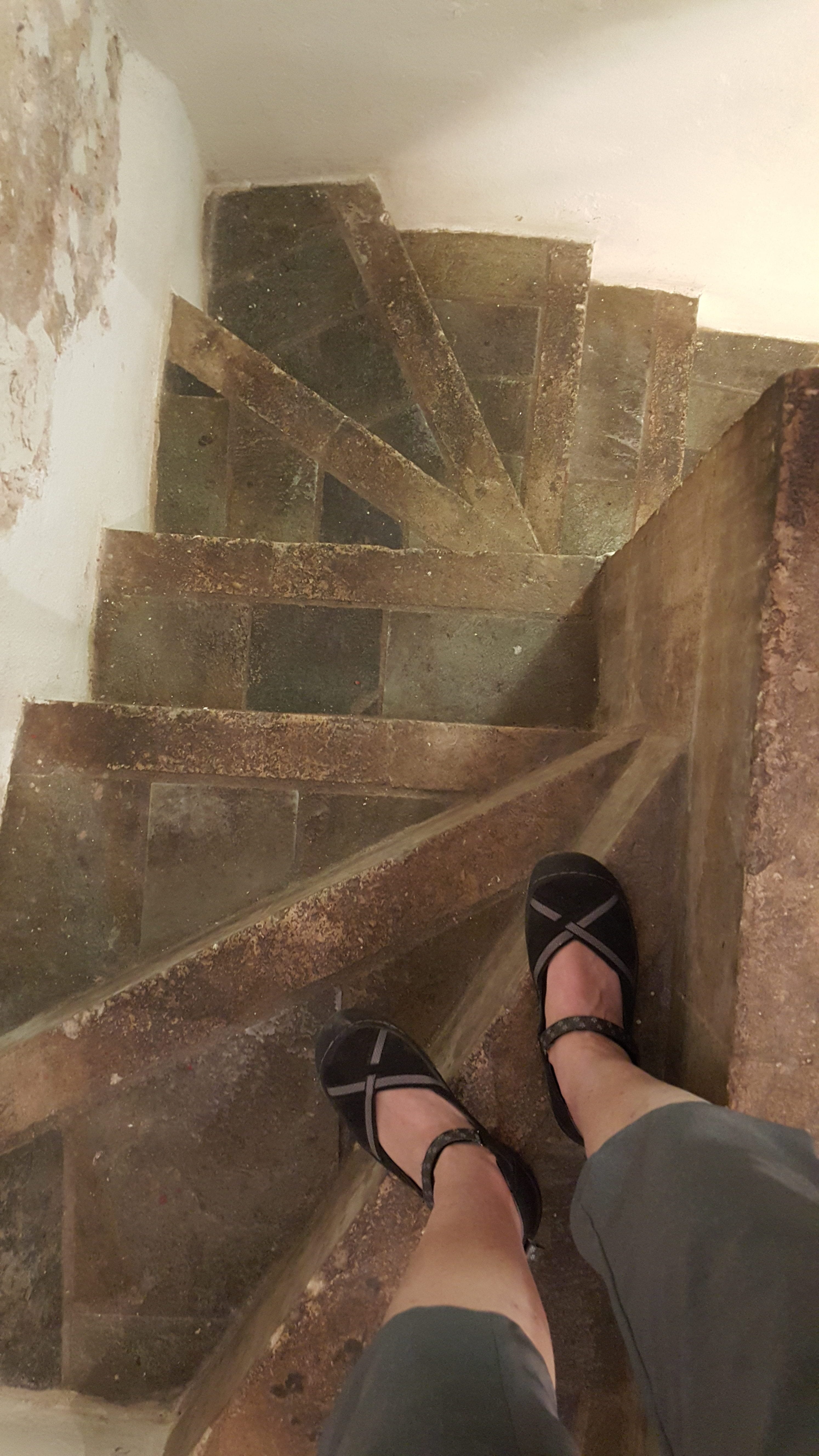
To reach Biscotto’s subterranean W.C., one has to descend a very tight spiral staircase
Having seen all they wanted to see in the medieval village, Michael and Nancy decided to catch a shuttle back to the little town on the mainland. There, in a boutique near the shuttle stop, Nancy was pleased to find exactly the type of hat she had been looking for all week: crushable crocheted cotton, made in Greece and not China. Soon we spied a group of friends huddled around a café table littered with half-empty glasses, everyone bent over a smartphone. We pulled up a couple of chairs and joined them, ordering a mango smoothie and peach juice to sip on while the six of us shared recent photos of our grandchildren and other bits of news from home.
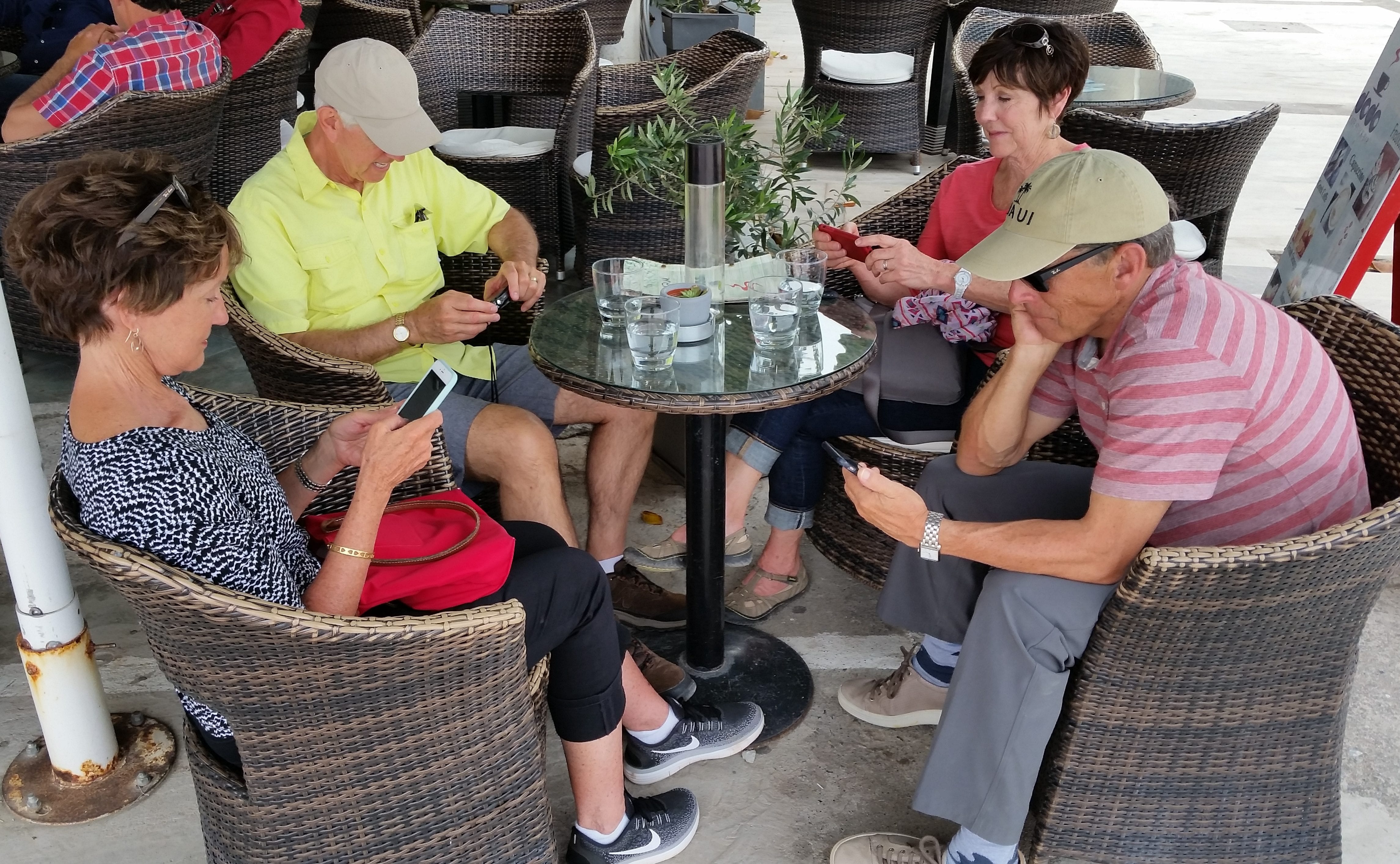
Linda, Budge, Nan, and Keith take advantage of free wifi to check the latest news from home
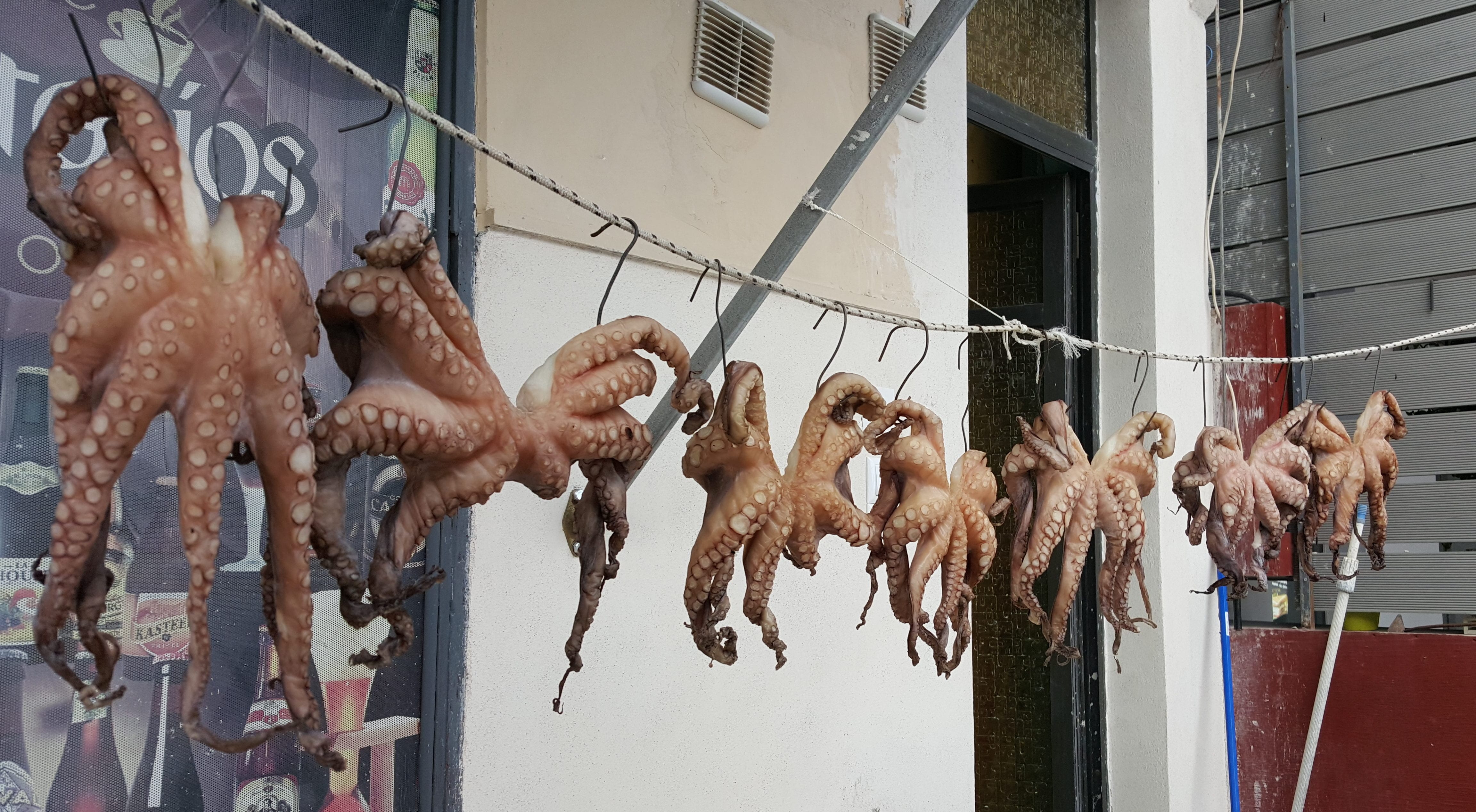
Nobody ordered octopus at the café, but if we had, we could have been sure that it was locally caught
The last tender back to the Wind Star would leave the pier at 5:30, but we took an earlier one so we would have time before dinner to do some laundry, reorganize our things, and pack. Tonight, we would have to leave large luggage outside our staterooms for porters to collect and have ready to load onto the airport shuttle early tomorrow morning. We also didn’t want to miss our final “sail away” ceremony as the Wind Star headed out to sea, especially because the beginning of this evening’s cruise promised a spectacular view of the whole cliffside village on Monemvasia, which we had yet to see. Every evening, passengers have thrilled to the theme from Master and Commander as the Wind Star’s sails unfurl, but with medieval Monemvasia as the dramatic backdrop, tonight’s “sail away” was the best of all.
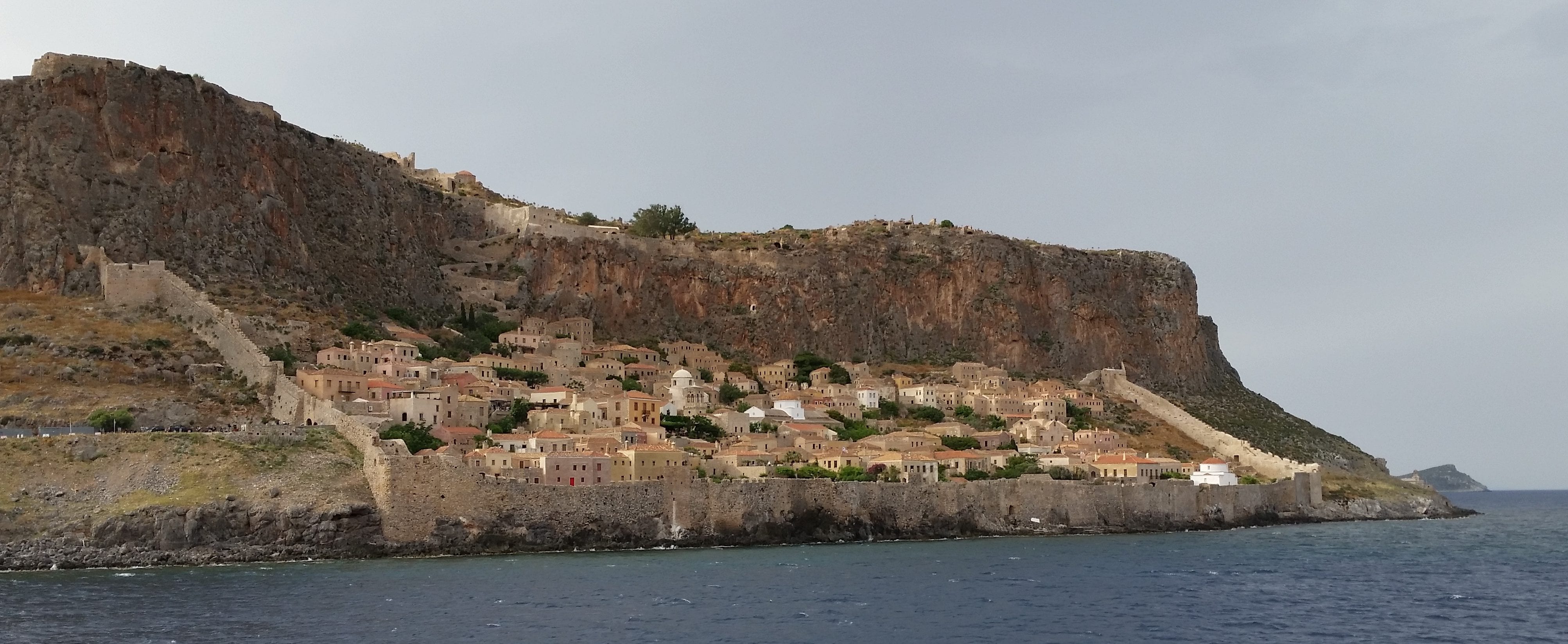
The medieval village of Monemvasia, protected by natural cliffs and massive stone walls, is visible only from the sea
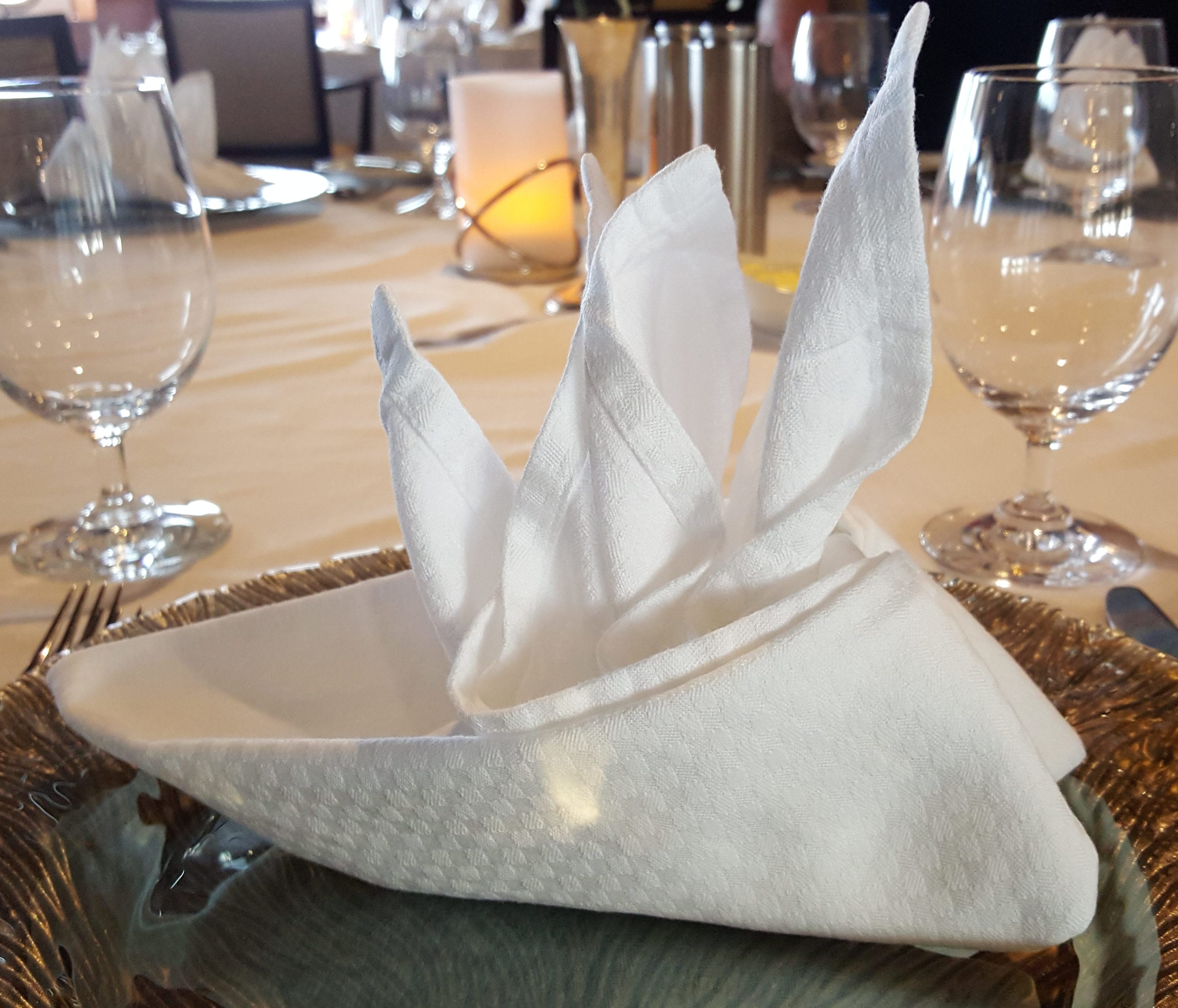
Our napkins were folded to resemble the Wind Star
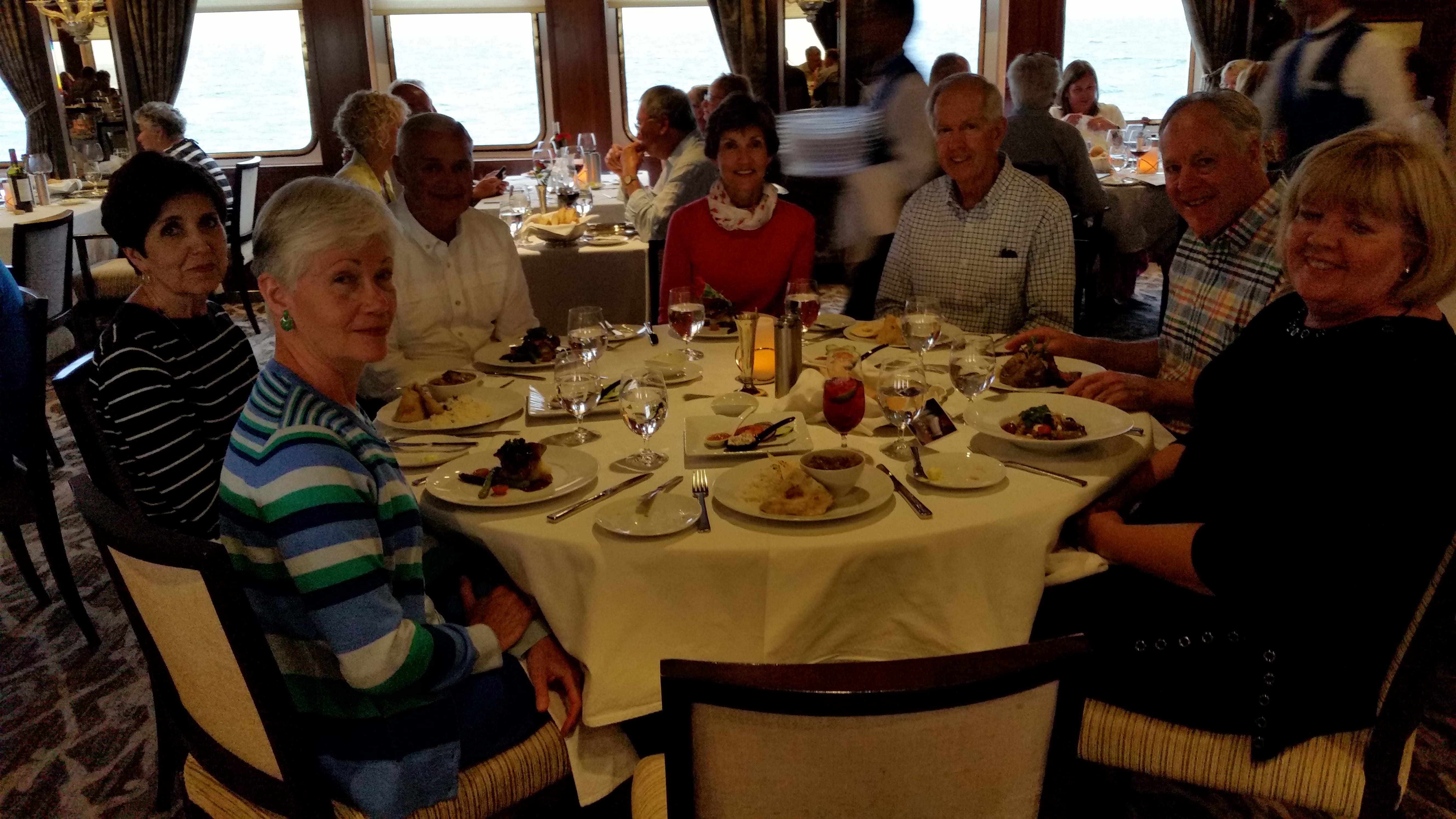
The table for our final dinner at AmphorA: Eva, Nancy, Barry, Linda, Budge, Jeff J, and Cathy
Michael had been looking forward to the Indian dishes Chef Budhi promised to put on AmphorA’s dinner menu tonight. His meal started with an excellent carrot-ginger soup and continued with a main course that included a northern-Indian chicken dish flavored with sixteen herbs and spices, basmati rice, roti (flatbread), raita (shredded cucumber in yogurt), poppadum (a crisp, spicy wafer), mango chutney, and sliced greens. Nancy chose the creamy fish chowder and Veal Marsala. The passion-berry mousse both ordered for dessert sounded irresistible but proved disappointing–too much gelatin. Michael thus felt justified in having ordered a second dessert: a much silkier chocolate pot au crème.
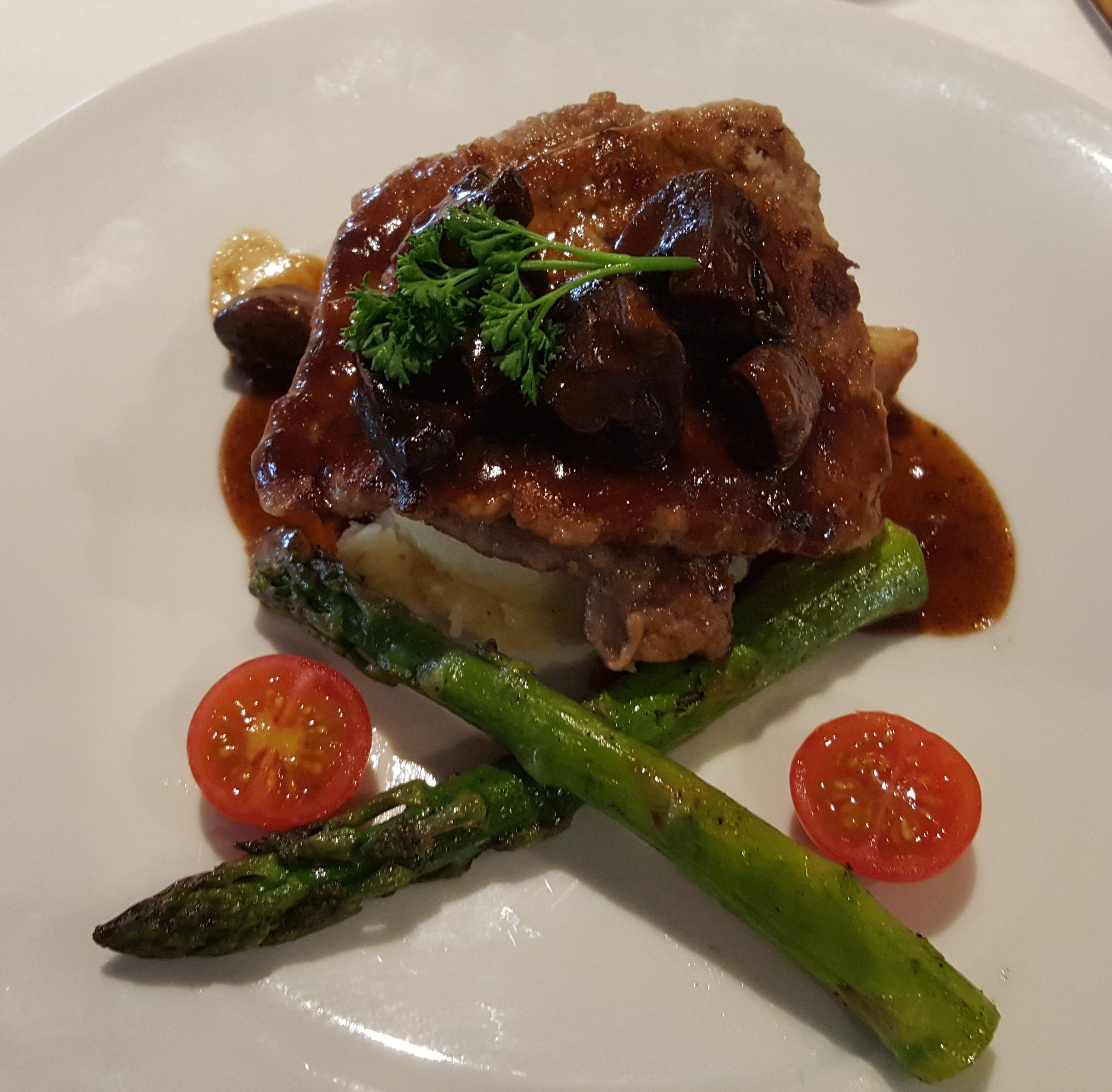
Nancy’s Veal Marsala was delicious
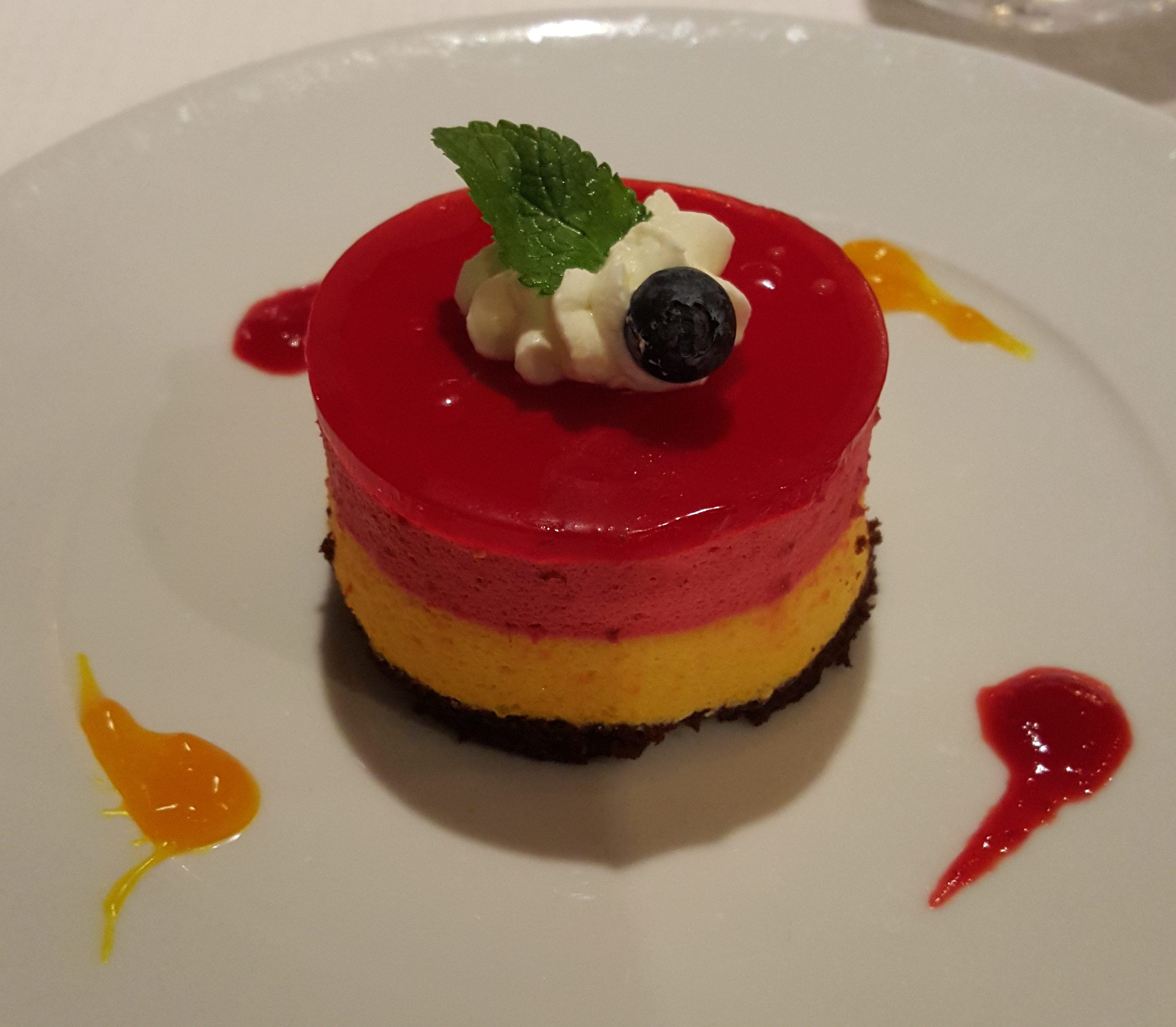
The passion-berry mousse looked fabulous but proved disappointing: too much like Jell-O
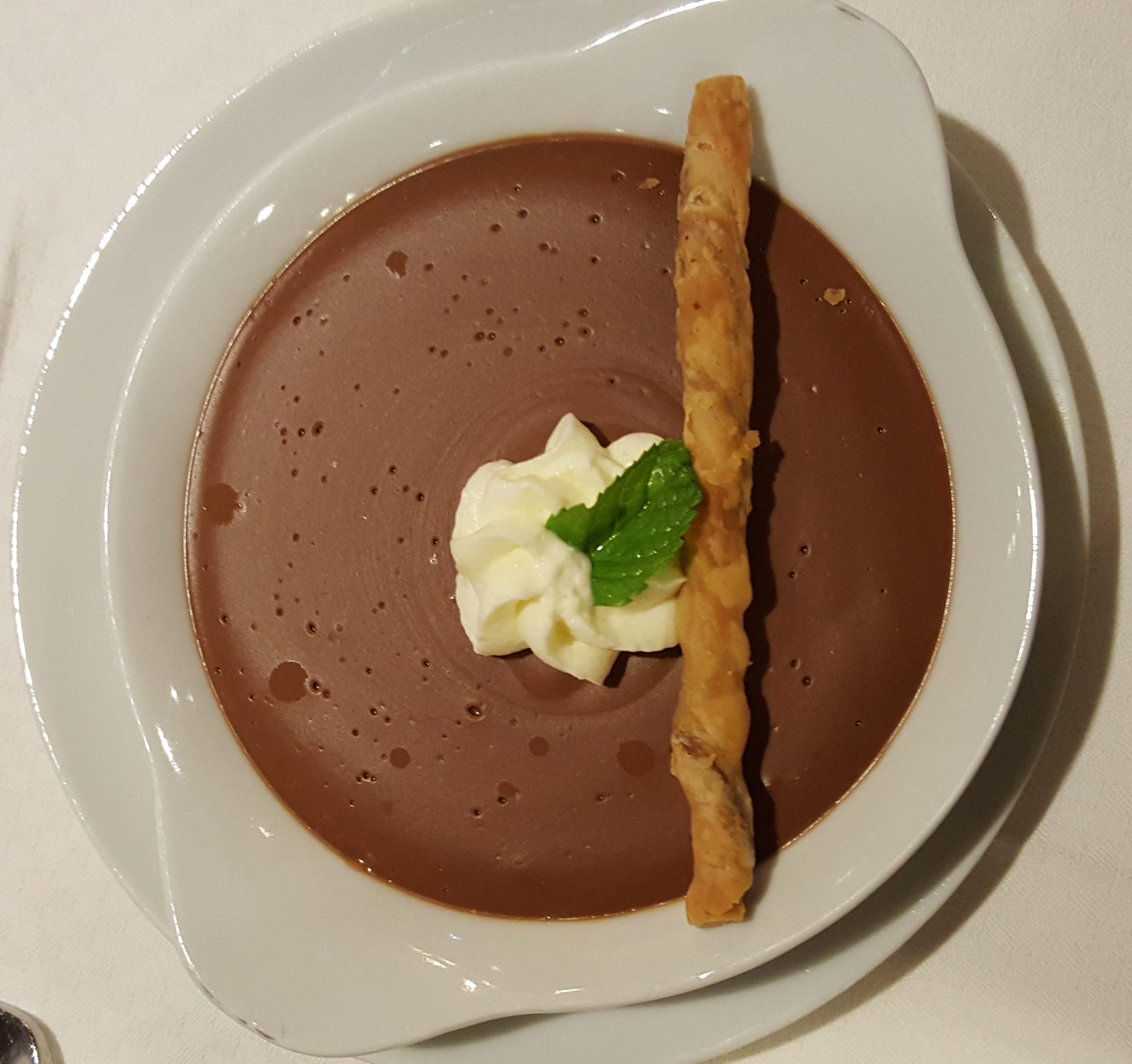
Michael’s pot au crème was more satisfying
No one lingered very long after dinner tonight, knowing that we all needed to put our luggage out before we retired and be ready to disembark at 7:15 tomorrow morning. However, before we could get into bed, we had to take one more long look at the mesmerizing waves gently rising and falling beneath the round, white moon.
Leave A Comment